Compiled by Geoff Goodall

Three Junkers G31s operated by Guinea Airways Ltd waiting to load cargo at Lae aerodrome, New Guinea during the 1930s.
The G31 in the foreground has its roof hatch removed. Ben Dannecker collection
The G31 in the foreground has its roof hatch removed. Ben Dannecker collection
The majority of Junkers aircraft imported by Australian owners during the 1920s-30s were operated in New Guinea by Guinea Airways Ltd.
This was a business registered in Adelaide, South Australia to provide air transport for the booming gold fields in the New Guinea mountainous highlands. The Mandated Teritory of New Guinea (later renamed Territory of Papua New Guinea) was administered by Australia until its independence in 1975. Guinea Airways commenced operations at Lae, New Guinea in April 1927 with British biplanes, a DH.37 G-AUAA and DH.9 G-AUFB, but quickly recognised the high demand for air transport and the need for more durable aircraft able to carry over a ton payload, which could withstand the harsh New Guinea tropical climate and rough airstrips.
Guinea Airways Board of Management in Adelaide decided on the all-metal Junkers aircraft range and set about raising the capital to order a Junkers W34 model. The Civil Aviation Branch (a predecessor of Department of Civil Aviation) advised the company that because Germany was not a member of ICAN (International Convention for Aerial Navigation), a forerunner of ICAO, German airworthiness certification could not be accepted - however Swedish certification for Junkers types built in Germany or Sweden by a Junkers associate company AB Flygindustri, would be acceptable to the Australian authorities. Accordingly, in October 1927 Guinea Airways cabled an order for a new Junkers W34 to Flygindustri at Malmo, Sweden.
When put into service to the New Guinea goldfields in April the following year, that first Junkers G-AUGZ paid for itself within the first 3 months! During its first 4 months of operation, it carried over 400 passengers and 295 tons of freight, three times more than that carried by all mainland Australian airlines combined, earning healthy profits for the small company. The Lae station manager and Chief Pilot E.A. "Pard" Mustar, recommended the purchase of a second W34 to the airline's frugal Board of Directors in Adelaide, which reluctantly placed an order for a second W34 which became G-AUJD. At that time there was little development in New Guinea to attract shipping from Europe, so alternate ways were devised to take delivery of the early single-engined Junkers, including fitting floats to aircraft unloaded at Rabaul and Melbourne, flying them to Lae where landplane undercarriage was installed. Over the new few years port facilities at Lae harbour were improved, which allowed later Junkers orders to be shipped direct to Lae.
All Guinea Airways Junkers models were modified with a removable roof hatch to enable bulky freight items to be loaded. The Junkers L5 engine powering most single-engined models proved underpowered for New Guinea conditions and Guinea Airways re-engined theirs with Bristol Jupiter, and later P&W Hornet radial engines. With its Junkers fleet Guinea Airways broke many world air cargo records. Throughout the 1930s Guinea Airways carried more freight each month than all the rest of the world's airlines carried that year. Between 1931-1941 Guinea Airways records show a gross airlift of 80,000 tons, including 8,804 tons during the year 1939, figures approached by no other aviation operator in the world.
Australian agent for Junkers imports was Major H.J. Berryman, Melbourne, who played an enthusiastic personal role in securing orders and supporting Junkers aircraft when delivered. At one time he had a newly-shipped Junkers Junior in his suburban backyard to avoid hangarage fees at Essendon Aerodrome until he found a purchaser.
Guinea Airways had invited other aircraft manufacturers, including Bristol, Fokker and Stout Metal Airplane Co (Ford), to match the 6,000 lb payload, but none could supply a suitable aircraft. An order was placed with Junkers for three G31 freighters with a detachable roof loading hatch, two of which were purchased by Bulolo Gold Dredging Co and the third by Guinea Airways Ltd, which would operate all three. The airline's Lae manager Alan Cross sailed for Gemany in February 1930 to test fly and take delivery of the G31s. There was a surge of relief through Guinea Airways Adelaide and New Guinea management when Cross cabled from the Junkers works on 29 September 1930 the news that he had flown the first G31 carrying 7,150 lbs of ballast to 7,900 feet in 12 minutes - furthermore with one engine shut down at 3,000 feet altitude the aircraft could still maintain a slow rate of climb. Despite the antipated perfomance drop in New Guinea's "hot and high" tropical climate, all were encouraged that the G31s would be able to do the job. That they did, breaking many world records for air freight in the process.
At Bulolo an airfield was constructed at the site of the proposed gold dredge, with a heavy duty crane to lift bulky cargo through the open roof hatch of the Junkers G.31s. Facilties at Lae airfield included a similar crane, sealed surface for the loading Junkers and underground aviation fuel lines. Within the first year of the Bulolo dredge operation, the Junkers trimotorsflew 20 return flights each week from Lae , each carrying an average load of 5,400 lbs.
It was a great success, allowing Bulolo Gold Dredging Co to commence operations at Bulolo Dredge No.1 during March 1932, followed by Bulolo Dredge No.2 in October that year. It was a complete success, and Guinea Airways was to air deliver the entire structure components for a further six gold dredges, the last in November 1939. Dredges No.5 and 6 required a heavier tumbler shaft weighing a massive 7,550 lbs (3,450 Kg). This was above the payload limit for the G.31 but the Civil Aviation Branch reviewed the request and approved these overload flights.
During 1933, although Bulolo Gold Dredging Company had no immediate requirement for another G31, their importance to the company's business justified the purchase of an additional aircraft VH-URQ. It was to be held as a back-up in the event of accidents and periods out of service for maintenance with the G31s already in service. The wisdom of this decision was confirmed only a few months after its delivery when VH-UOU suffered serious structural damage in a takeoff accident at Lae and was out of action for 19 months.
The Guinea Airways Junkers trimotors could lift 16 tons of freight, which allowed a big drop in New Guinea air freight rates, which had to be matched by rival operators like Holdens Air Transport, Stephens Aviation, Mandated Airlines. Roads to the goldfields had not been built and the during the 1930s, the Junkers G31s flew the structures and machinery for a second dredge at Bulolo, also dredges and golf milling plants at Wau, Edie Creek and Golden Ridges, Bulwa. On one occasion, a large consignment of dredge parts arrived unscheduled by ship from Sydney, while several Guinea Airways G31 pilots were on leave in Australia. Ian Grabwosky personally flew 20 round trips Lae-Bulolo over 5 consecutive days in stifling tropical heat to deliver the heavy metal components. A remarkable feat by the pilot, ground cargo handlers, crane operators and machine.
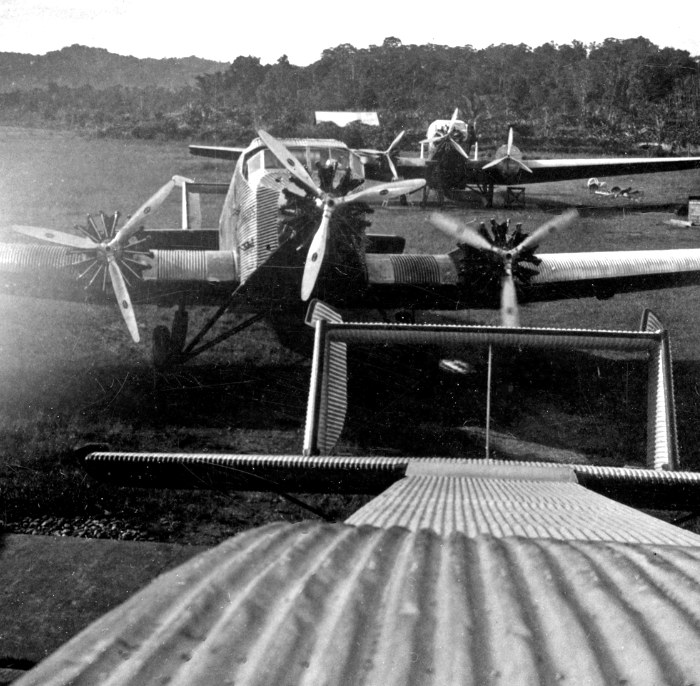
The currugated metal surfaces of the Junkers G31 trimotors can be seen in this view taken from the open roof hatch
of a Guinea Airways G31 at Lae circa 1936. Photo by Bert Heath, via Ben Dannecker collection
of a Guinea Airways G31 at Lae circa 1936. Photo by Bert Heath, via Ben Dannecker collection
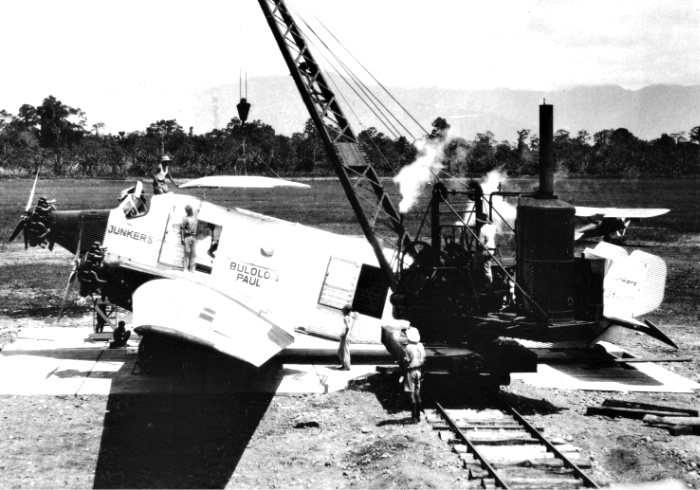
Junkers G31 VH-UOU at Lae, having its roof loading hatch lifted off by the steam driven crane mounted on rails.
Photo: Civil Aviation Historical Society
Photo: Civil Aviation Historical Society
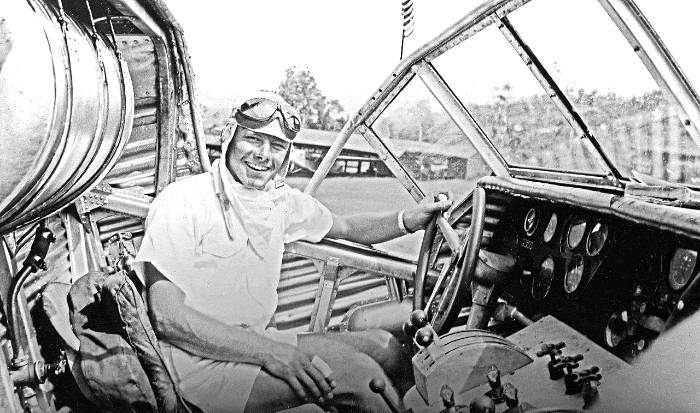
Guinea Airways pilot George Cannon in the left hand seat of a Junkers G31. Neil Follett collection


Civil Aviation Historical Society
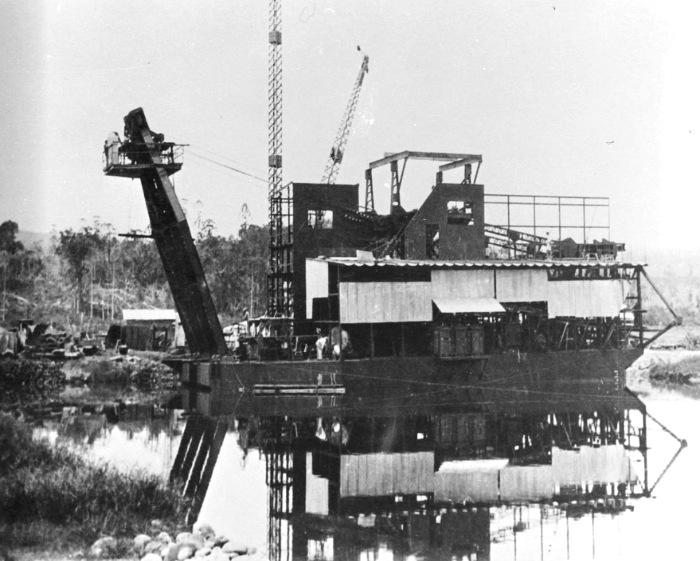
Bulolo No.1 Dredge. All components had been manufactured in Sydney, shipped to Lae, then flown by Junkers G31
trimotors to Bulolo for assembly. Size can be gaged by the man in white overalls bending over on the bottom deck.
Photo: Civil Aviation Historical Society Ian Grabowsky collection
trimotors to Bulolo for assembly. Size can be gaged by the man in white overalls bending over on the bottom deck.
Photo: Civil Aviation Historical Society Ian Grabowsky collection
The
delivery of a Junkers Ju 86 eight passenger airliner from Germany in
March 1937 was the final Australian pre-war Junkers. Although it may
seem to be a surprising aircraft type to bring to Australia for
demonstration and hopefully sale, at that time the Ju 86 looked to be a
viable all-metal airliner smaller than the DC-2 for services with lower
passenger loadings. Australian Transcontinental Airlines proposed using
Ju 86s on its Adelaide-Darwin routesand a small Melbourne airline
Southern Airlines and Freighters Ltd had big plans to compete with ANA
by importing seven Ju 86 airliners. SA&F Director Ian H. Grabowsky had previous flown Junkers aircraft with Guinea Airways in New Guinea.
In addition, the two largest Australian airllnes wanted to purchase new generation of all-metal all-weather airliners to replace their fleets of fabric covered British biplanes. Australian National Airways and Airlines of Australia were placing orders for Douglas DC-2s which had lengthy delivery delays. AofA purchased Stinson A trimotors in the interim, and there was concern that the new DC-2s and DC-3s would be too big for the passenger loads offering. The Junkers Ju 86 airliner seemed a good choice to fill a smaller all-metal airliner category. The Royal Australian Air Force was reportedly also interested in the Ju 86, but for what role is unclear.
Negotiations by Southern Airlines and Freighters Ltd to finance seven Ju 86s by off-setting partial cost against Australian wool, then in high demand worldwide, came to the attention of prominent Sydney wool broker Mr.E.F.H. Beinssen, who was also German Trade Commissioner. He was able to arrange a barter/exchange deal with Junkers for a Ju 86 demonstrator, paid for by a £23,000 (Australian) shipment of top grade Australian wool. Beinssen had already interested Mr.G.A.Robinson, Managing Director of Airlines iof Australia who agreed to lease the Ju 86 on arrival for evaluation on the AofA Sydney-Brisbane-Townsville route. Beinssen was confident the aircraft would be sold to AofA or one of the the other interested airlines.
It was not to be - refer Junkers Ju 86 VH-UYA at the end of the listing below.
In addition, the two largest Australian airllnes wanted to purchase new generation of all-metal all-weather airliners to replace their fleets of fabric covered British biplanes. Australian National Airways and Airlines of Australia were placing orders for Douglas DC-2s which had lengthy delivery delays. AofA purchased Stinson A trimotors in the interim, and there was concern that the new DC-2s and DC-3s would be too big for the passenger loads offering. The Junkers Ju 86 airliner seemed a good choice to fill a smaller all-metal airliner category. The Royal Australian Air Force was reportedly also interested in the Ju 86, but for what role is unclear.
Negotiations by Southern Airlines and Freighters Ltd to finance seven Ju 86s by off-setting partial cost against Australian wool, then in high demand worldwide, came to the attention of prominent Sydney wool broker Mr.E.F.H. Beinssen, who was also German Trade Commissioner. He was able to arrange a barter/exchange deal with Junkers for a Ju 86 demonstrator, paid for by a £23,000 (Australian) shipment of top grade Australian wool. Beinssen had already interested Mr.G.A.Robinson, Managing Director of Airlines iof Australia who agreed to lease the Ju 86 on arrival for evaluation on the AofA Sydney-Brisbane-Townsville route. Beinssen was confident the aircraft would be sold to AofA or one of the the other interested airlines.
It was not to be - refer Junkers Ju 86 VH-UYA at the end of the listing below.
| 4.29 |
Built at Dessau by Junkers Flugzeug und Motorwerke A.G. Junkers F 13L, c/n 2044. One 310hp Junkers L5 six cyclinder inline engine. |
| Ordered by a newly-formed company Eyre Peninsular Airways Ltd, Adelaide, South Australia The company was registered 2.11.28 in Adelaide with directors J.H.Moate and Albert G.Packer, to operate airline services from Adelaide to South Australian regional towns on Eyre Peninsular. |
|
| 18.4.29 |
Swedish CofA was issued in the Luftvardighetsbevis series for aircraft receiving Swedish CofA but no Swedish registration. This was a Junkers arrangement to cover foreign exports while Germany was not a member of ICAN, making German airworthiness certification unacceptable to Australia. Sweden was an ICAN member and Swedish certification was acceptable to the Australian Civil Aviation Branch. |
| 5.29 |
Shipped from Hamburg to Australia |
| 19.6.29 |
Arrived Port Melbourne on ship SS Karrnak. Moved by road to Essendon Aerodrome for assembly |
| 25.6.29 |
Test
flown Essendon after assembly, pilot A.E."Pard" Mustar of Guinea
Airways, who was highly experienced on Junkers single-engined types. |
| 25.6.29 |
Registered VH-UKW: Eyre Peninsular Airways Ltd, Adelaide SA |
| 25.6.29 |
Australian CofA issued |
| Named "Mount Wedge"
after Mount Wedge Station on Eyre Peninsular, whose owner John Bascomb
was the main shareholder in Eyre Peninsular Airways. |
|
| 9.7.29 |
Delivered from Melbourne to Adelaide by Pard Mustar. Based Parafield Aerodrome, Adelaide |
| 21.7.29 |
VH-UKW
arrived Port Lincoln from Adelaide on a preliminary survey flight to
assess landing grounds around Eyre Peninsular. Pilot was James
Mollison, Aero Club of SA instructor, who had been engaged by EPA as
its only pilot. |
| 8.29 |
Commenced scheduled passenger services from Parafield Aerodome, Adelaide, pilot Mollison: Twice weekly: Parafield-Whyalla-Cowell-Port Lincoln-Elliston-Streaky Bay-Parafield |
| 7.1.30 |
Forced landing Windsor SA due boiling radiator on a hot day, no damage. Pilot Orm Denny was ex RAAF and had been engaged by EPA to replace Jim Mollison |
| 8.1.30 |
Flew Adelaide-Broken Hill NSW return. Inaugural scheduled new weekly service began 15.1.30. |
| 9.3.30 |
Forced
landing Darkes Peak, Caralue SA when the propeller sheared off in
flight at 3,000 feet altitude due to
crankshaft failure. Pilot Orm Denny made a long glide to find a
suitable clearing to land, selecting a flat farm paddock with only
minor
damage. Passengers were taken to Adelaide by road. |
| 3.30 |
Replacement engine installed in situ and aircraft flown out by Denny. |
| 7.30 |
Eyre
Peninsular Airways ceased operations and the company was in
liquidation. The Directors blamed increased Government duty of fuel and
onerous sales tax requirements. Ownership of VH-UKW was transferred to company Director Mr.J.H.Moate, Adelaide. |
| 30 |
A new company Goldfields Air Navigation Ltd
was formed at the mining town Kalgoorlie WA by Mr.J.H.Moate to take
over the assets and organisation of Eyre Peninsular Airways and operate
regular air services from Kalgoolie to Wiluna and Esperance. |
| 18.12.30 |
VH-UKW
arrived Kalgoorlie on ferry flight from Parafield, pilot Captain
Haddow. After arrival its scarlet paintwork was repainted in silver and
black. |
| 7.1.31 |
Civil Register change of ownership: Goldfields Air Navigation Ltd, Kalgoorlie WA Company Secretary Mr.J.H.Moate |
| 1.31 |
GAN had planned to
commence services from Kalgoorlie from 1 January 1931 but was delayed
while waiting for sellected landing grounds to be prepared at Leonora,
Wiluna, Norseman, Salmon Gums and Esperance. Company pilot was Captain
D.P.Hadow . |
| 2.2.31 |
Inaugural GAN sheduled service, Kalgoorlie-Wiluna, pilot Stewart E. "Sutty" Sutcliffe. The weekly service was scheduled to connect at Kalgoorlie with the West Australian Airways Perth-Adelaide service, but the GAN service was discontinued after a month due to poor patronage. |
| 20.2.31 |
VH-UKW arrived at Perth on a charter flight. |
| 23.2.31 |
Landing
at Merredin WA during the return flight from Perth, the tail skid
struck a tree stump,wrecking the assembly and severing the rudder
control cable, which snapped back into the cockpit injuring pilot
S.E.Sutcliffe's leg. |
| 4.31 |
Pilot G.K.Rice-Davey was engaged by EPA to replace S.E. Sutcliffe who had been employed by West Australian Airways |
| 6.31 |
Goldfields
Air Navigation request CAB approval for the WAA Kalgoorlie-based
engineer to sign out maintenance on the Junkers VH-UKW. |
| 24.8.31 |
Flew a passenger charter from Kalgoorlie to Leonora. Next day flew to Wiluna and Kalgoorlie. |
| 10.31 |
Goldfields Air Navigation has ceased operations and is in liquidation. Guinea Airways is negotiating the purchase of their only aircraft VH-UKW. |
| 15-20.10.31 |
VH-UKW ferried from Kalgoorlie to Sydney by Captain Charles Snook, carrying 5 passengers. (Snook was based in Kalgoorlie at that time in charge of two DH.84 Dragons operating a two-year minining aerial survey for Western Mining Co. He later formed Airlines (WA) Ltd at Perth.) |
| 21.10.31 |
Change of ownership: Guinea Airways Ltd, Lae, New Guinea Fleet Number "Junkers No.6" |
| Shipped from Sydney to Lae. Total airframe time on arrival was 890 hours. Accompanied on the ship by pilot Orm Denny who had been engaged by Guinea Airways. Overhaul by Guinea Airways at Lae before entering service, retained passenger seating to be used to operate a planned new service linking the goldfields with the capital city Port Moresby. Denny surveyed the route in a Fox Moth on 29.2.32, recording possible forced landing sites. |
|
| 23.3.32 |
VH-UKW
operated the inaugural scheduled service Port Moresby-Wau, pilots Orm
Denny and Frank Drayton. The service was three-weekly to connect with
the coastal mail steamer ship from Australia. Average flying time was 2
hours. |
| 5.32 |
CAB inspection report: airframe time now 1,031 hours |
| 28.9.32 |
Frank Drayton & Orm Denny made the first landing at a newly constructed strip at Kokoda carrying supplies for American mining engineer J.Ward Williams. Followed by many supply runs to Kokoda. |
| 30.9.32 |
Inaugural official airmail service Port Moresby-Wau carrying mail transferred from boat from Australia, pilot Frank Drayton. |
| 10.32 |
Extended overhaul by Guinea Airways at Lae during which the Junkers L5 engine was replaced by an
uncowled 425 hp Bristol Jupiter VI 9-cylinder radial to improve performance and for standardisation with Guinea's other singe-engined Junkers. |
| 1.12.32 |
Returned to service after overhaul. |
| 2.12.33 |
While operating a
second Port Moresby-Wau service that day, flown by Orm Denny with
newly-arrived pilot Aub Koch, caught in cloud and attempted to return
to Port Moresby. After 3 hours with fuel state low, Denny saw a gap in the cloud and made a landing on a hard sand beach near Kukipi without damage. Denny and two passengers set off on foot to find help, found a disabled launch in which they reached Port Moresby that same evening. The Junkers was flown out the next day. |
| Following the Kukipi forced landing, an extra fuel
tank was installed to increase endurance by an hour. |
|
| 11.35 |
Completed overhaul at Lae by Guinea Airways during which the 425hp Bristol Jupiter was replaced by an uncowled 525 hp P&W R-1690 Hornet A2 9-cylinder radial engine. Total airframe time now 2,371 hours |
| 11.11.37 |
Damaged when swung violently during landing at Slate Creek, New Guinea. Pilot Syd N.Wiltshire |
| 15.10.38 |
Undercarriage collapsed landing Salamaua. Pilot W.J.Robins |
| 26.8.39 |
Crashed at Narakapor, near Nadzab, New Guinea due to engine failure. Pilot Les H. Ross |
| Wreckage transported to Lae where stored in a Guinea Airways hangar pending rebuild. Total airframe time 4,846 hours |
|
| 17.1.42 |
CofA renewed at Lae after rebuild |
| 21.1.42 |
Destroyed by Japanese air raid on Lae Aerodrome which demolished the Guines Airways base and parked aircraft. |
| Note:
several souces quote VH-UKW as the derelict Junkers which remained at
Alexischhafen Mission until the 1980s, but that was VH-UIW. |
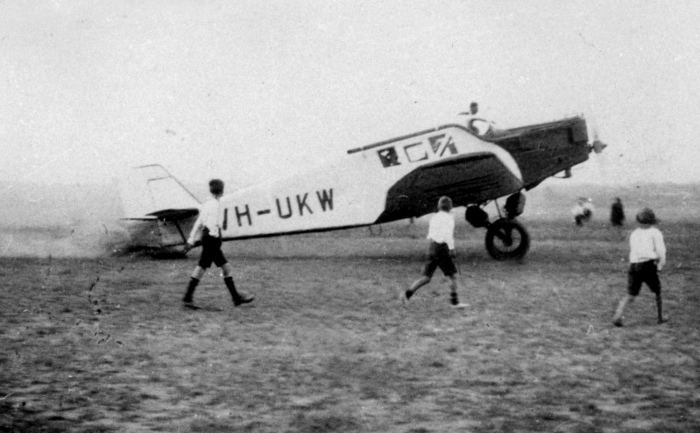
This and the following picture show Eyre Peninsular Airways' VH-UKW visiting Yorktown SA during 1929-1930.
Geoff Goodall collection
Geoff Goodall collection
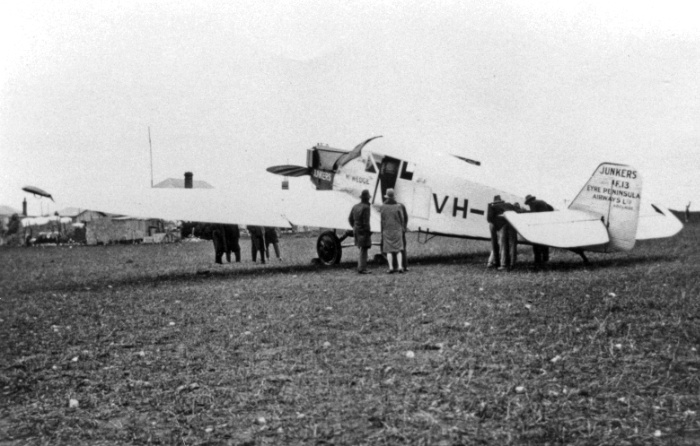

West Australian Airways hostel for overnighting passengers on the WAA Adelaide-Perth DH.66 Hercules services.
Nigel Daw collection
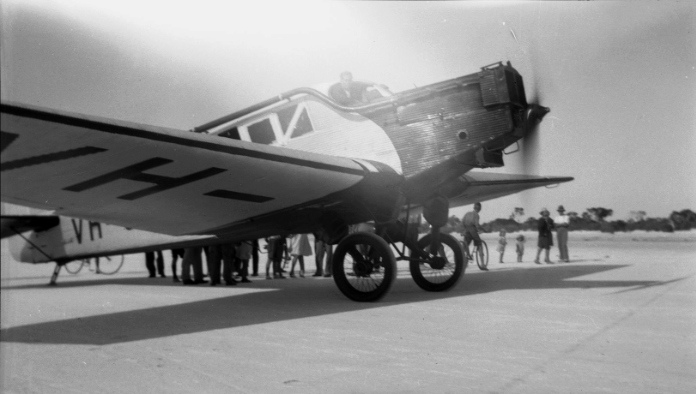
The pilot is leaning out of the the opened right cockpit window. Photo via Nicholas Kleinig
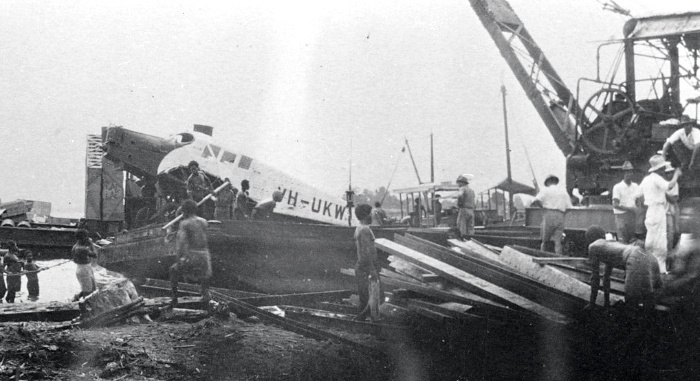
Two views of VH-UKW being barged ashore at Lae after being shipped from Sydney for Guinea Airways.
Both courtesy of the Civil Aviation Historical Society Ian Grabowsky collection
Both courtesy of the Civil Aviation Historical Society Ian Grabowsky collection

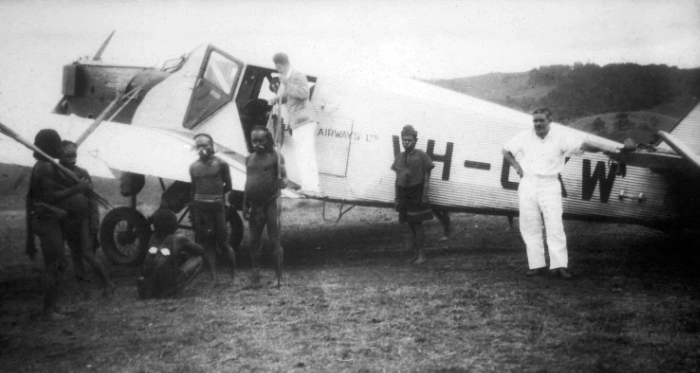
VH-UKW in New Guinea during 1932, still with the Junkers L-5 in-line engine and passenger seating.
Civil Aviation Historical Society
Civil Aviation Historical Society
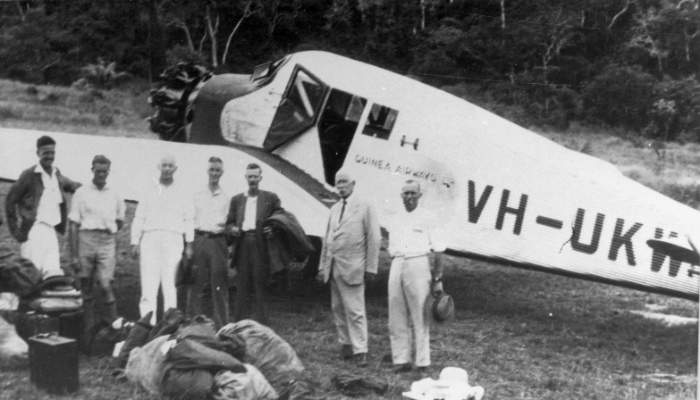
Now re-engined by Guinea Airways with a Bristol Jupiter radial.
Alan Bovelt collection

| .30 |
Built at Dessau by Junkers Flugzeug und Motorwerke A.G. Junkers F 13L, c/n 2075 One 460hp Armstong Siddeley Jaguar 14 cylinder two row radial engine without cowlings |
| Leased from Junkers by Bishop and O'Sullivan Aircraft Service, trading as Sky Travel Pty Ltd, Brisbane Queensland |
|
| Sky Travel Pty Ltd, Brisbane was registered in Queensland, and had no connection with Sky Travel Ltd at Sydney which was formed in January 1928 by partners Ruppert King (flying instructor) and George Mills (Dentist with pilot licence). Both companies went out of business around the same time due to the slump in demand because of the 1930s Depression. |
|
| The
Queensland Sky Travel Pty Ltdc was formed by Messrs T.H.Bishop and
M.O'Sullivan, both Brisbane insurance assessors who had previously had
hired light aircraft to travel for insurance work. First aircraft was
DH.60 Moth G-AUGH, which was mostly used for joyriding. During 1929 it
was painted with "Wunda" under the wings to advertise Wunda Wax floor polish and flown on tours of Queensland towns by company pilot T.R."Tommy" Young. He had been employed in
December 1928, having previously been a ground engineer with Qantas at
Longreach and Archerfield. For a period during 1929 the Moth was fitted
with neon tubes under the wings to spell out "Wunda" and flown at night
over Brisbane by Young. Second aircraft was a three seater
Simmons Spartan VH-UMP purchased newin December 1929. |
|
| : "Sky Travel then leased, in November 1930 the Junkers F13L VH-UPL. This was a five passenger aircraft fitted with a 14 cylinder Jaguar engine. It had seating for two pilots out in the weather in an open cockpit. I wasn't a very comfortable aeroplane to fly because you had no shelter but at the time it was the most modern aeroplane in the country.
It was fitted with extra instruments for night flying and landing
lights and search lights. In the cabin you could walk behind the rear
seat to a lavatory at the back. Lavatories in aircraft were unheard of
in those days." |
|
| Swedish CofA was issued in the Luftvardighetsbevis series for aircraft receiving Swedish CofA but no Swedish registration. This was a Junkers arrangement to cover foreign exports while Germany was not a member of ICAN, making German airworthiness certification unacceptable to Australia. Sweden was an ICAN member and Swedish certification was acceptable to the Australian Civil Aviation Branch. |
|
| Shipped to Australia on board SS Tancred |
|
| 28.10.30 |
Arrived Port Melbourne. Unloaded and moved to Essendon Aerodrome for assembly. Australian Junkers agent Major H.J.Berryman had arranged for former Junkers engineers Gustav Mueller now with Guinea Airways and Carl Isler who was to maintain VH-UPL during its lease, to be in Melbourne to carry out the assembly. With their experience, assembly took less than two days. |
| Former Junkers test pilot Captain Walter Rothe was staying at Major Berryman's home in Melbourne at the time, following his
misadventures in New Guinea flying the F.13 VH-UIW - see below. |
|
| 1.11.30 |
Test flown Essendon by Walter Rothe |
| 2.11.30 |
Walter Rothe checked out Sky Travel's pilot Captain T.R.Young on the aircraft. (Rothe then returned home to Germany) |
| 6.11.30 |
Registered VH-UPL: Sky Travel Pty Ltd, Brisbane QLD |
| 6.11.30 |
Australian CofA issued |
| 15.11.30 |
Departed Essendon on delivery flight to Brisbane, flown by Captain Young and carrying Junkers engineer Carl Isler. Reached Archerfield Aerodrome, Brisbane 18.11.30. (Isler was to stay on in Australia after the VH-UPL lease and join Guinea Airways) |
| 11.30 |
VH-UPL was named Glorious Queensland in a ceremony at Archerfield. |
| Tom Young later recalled: "It
was the most beautiful aeroplane to fly and you could side-slip or do
anything with it. It did however have a nasty habit of ground-looping
because of loss of rudder control due to blanketing and the Jaguar
engine wasn't very reliable. I had four force landings due engine
trouble. We used the Junkers on joyriding between the airline runs." |
|
| Sky Travel proposed to use the Junkers to operate scheduled airline services: Brisbane-Toowoomba-Goondiwindi-St George Brisbane-Toowoomba-Kingaroy-Murgon-Nanango-Wandai-Goomeri-Mundubbera |
|
| 21.11.30 |
Captain T.R.Young flew VH-UPl Brisbane-Goondiwindi to promote the planned air service. The
town had no airfield so a salt pan near town was used to conduct joy
flights. |
| 22.11.30 |
Flew to St George where Young landed on the town racecourse. |
| 29.11.30 |
Sky Travel commenced airline services Brisbane-Goondiwindi-St
George. On board for the inaugural flight were politicians, a newspaper
reporter and company Director T.H.Bishop. Services commenced on other routes including Maroochydore |
| 6.12.20 |
Flew Brisbane-Maryborough where conducted joyrides (total 125 passengers) |
| 26-27.12.20 |
Joyrides from a new landing gound at Maroochydore (total 304 passengers) |
| 2.31 |
Sky Travel Ptyy Ltd ceased scheduled services because ofpoor poor patronage. Final service to Maroochydore 10.1.31, Kingaroy 17.1.31 and St George 11.2.31. |
| 15.2.31 |
Final joyriding session, conducted at Eagle Farm airfield, Brisbane. |
| VH-UPL was retired at Archerfield. The Lease from Junkers was terminated. |
|
| 27.8.31 |
Tom Young departed Archerfield on a ferry flight to Melbourne with engineer Carl Isler, to
return the aircraft to Junkers agent Major Berryman. |
| Berryman arranged a enroute demonstration to Lismore motor dealer George A. Robinson,
founder and Managing Director of New England Airways operating
Sydney-Lismore-Brisbane scheduled services with a Ryan B.1 and DH.80
Puss Moth but planning to purchase Avro 10s. Young landed at Lismore to collect Mr.Robinson who accompanied him to Sydney. |
|
| 28.8.31 |
Forced
landing at Illabo NSW (near Junee) because of engine magneto problems
while flying in poor weather. The magneto drive
problem was rectified and the flight continued to Melbourne. |
| Dismantled at Essendon and packed for shipping by engineer Carl Isler |
|
| Shipped to South Africa |
|
| 6.32 |
Registered ZS-ADR Union Airways Pty Ltd, Durban, South Africa |
| .34 |
Change of name to South African Airways when the SA Government took over Union Airways |
| c40 |
ZS-ADR was impressed by South African Air Force as serial 1429 |
| Fate unknown |
|
| Compiler's comment: aviation
historians have sometimes questioned why this aircraft was exported
rather than being purchased by Guinea Airways, an enthusiastic Junkers
operator. The answer probably lies in the financial reality that by the time Junkers agreed to end the lease of VH-UPL and sell it within Australia, Guinea Airways had just negotiated the purchase of Junkers F13 VH-UKW from the defunct Goldfields Air Navigation Co at a business liquidation low price. |


In South Africa in service with Union Airways, forerunner of South African Airways
| Built at Dessau by Junkers Flugzeug und Motorwerke A.G. Junkers F 13ke, c/n 2074. One 310hp Junkers L5 six cylinder inline engine. |
|
| 22.8.30 |
Registered G-ABDC Personal Flying Services Ltd, Heston Aerodorme, London |
| 22.8.30 |
Delivered via Rotterdam to Croydon Aerodrome, London |
| 23.8.30 |
British CofA issued |
| 10.4.33 |
Change of ownership Brooklands Airways Ltd, Brooklands Aerodrome, Surrey |
| 34 |
The
Neuendettelsau Lutheran Mission in New Guines had mission stations at
Nadzab, Kaiapit, Amari, Kambaidam, Mumeng and Boana and keeping them
supplied overland was difficult. It was decided an aeroplane was
needed. The Board of Lutheran Missions at Neuendettelsau,
Bavaria approached Junkers, which offered a second-hand Junkers F13
fully overhauled in perfect condition. The purchase price was raised by
New Guinea missionaries and evangelists deducting sums from their
monthly allowances. |
| 12.34 |
Registered in Sweden SE-AEC Lutheran Mission Germany This Swedish registration was a clerical exercise to obtain a Swedish CofA to satisfy the Australian authorities. Swedish CofAs for earlier Junkers imports had not required a Certificate of Registration, but such earlier arrangements had probably ceased since Hitler's National Socialists Party had come to power in Germany. |
| 8.12.34 |
Shipped from Hamburg |
| 19.2.35 |
Arrived
Lae by ship, accompanied by former Lufthana Captain Fritz Loose, who
had signed a two year contract to fly the Junkers for the New Guinea
mission. He was a WW1 German fighter pilot who had
been banned from airline flying in Germany because of his personal
disagreement with policies of Hitler's Nazi Government. A German engineer followed. |
| Junkers was erected at Lae aerodrome by Guinea Airways assisted by Fritz Loose. Fitted with 4 passenger seats on arrival. |
|
| 28.2.35 |
First test flight at Lae by Fritz Loose |
| 7.3.35 |
Registered VH-UTS Lutheran Mission, Finschhafen, New Guinea Named "Papua" which was painted in white on the black nose cowling |
| 7.3.35 |
Australian CofA issued. Fitted with 6 passenger seats, easily removable for freight. |
| 17.4.35 |
Dedication
ceremony for the Junkers and its crew was held at Heldsbach airfield at
the Finschhafen Lutheran Mission headquarters. |
| Junkers
was at first based at Lae airfield but in May 1935 moved to a new
airfield built on mission land a short distance away at Malahang. It had a busy schedule flying supplies and personnel between the outstation missions which had cleared basic airstrips. The engineer accompanied the pilot on all flights. |
|
| 3.36 |
Aircraft inspection report: total airframe time: 879 hours |
| Fritz Loose returned to Germany in February 1938: he had flown a total of 280 tons of freight and many passengers in VH-UTS without serious problems. He was replaced by Werner Garms, a young German national with limited flying experience, who spoke little English. | |
| 11.3.38 |
Damaged,
heavy landing and ran off Kundiawa airstrip Chimbu. Pilot Werner Garms unhurt. |
| The Junkers L5 engine gave inadequate performance for New Guinea flying. DCA received a report that mission pilot Garms and aircraft engineer Paul Raabe intend to change the engine on VH-UTS to a P&W Wasp radial salvaged from Sikorsky S-38B VH-UZE which crashed and sank landing on the Kikori River on 27.12.37. DCA sent a letter to the Lutheran Mission reminding them of Departmental requirements before a change of engine could be approved. No reply, nothing further in DCA file. However it is reported that the mission purchased two P&W Hornet engines. |
|
| 11.38 |
While Garms was away on leave, a relief pilot Captain
Habenstein badly damaged VH-UTS when he lost control during on his
first familiarisation flight at Malahang airfield, Lae. |
| 2.39 |
Returned to service after repair at Lae airfield. Guinea Airways allowed the Junker's engineer Paul Raabe to use a Guinea Airways workshop hangar for his rebuild, labour provided by mission staff. |
| 9.39 |
With
the outbreak of war in Europe on 1 September 1939 and Australia's
declaration of war against Germany, Werner Garms and Paul Raabe were
anxious to avoid being interned. The pair had flown VH-UTS on a routine supply run from Malahang strip, Lae to Ogelbeng Lutheran Mission station near Mount Hagen. They decided to steal the Junkers to fly out of Australian territory then make their way back to Germany to join the Luftwaffe. |
| 5.9.39 |
Garms
and Raabe flew VH-UTS from Mount Hagen to Edie Creek airfield where they
topped up fuel from the Lutheran Mission fuel stocks. They tnen flew to
Merauke, Dutch New Guinea. After landing at Merauke Aerodrome, the pair abandoned the aircraft and stealthily made their way into town. |
| Garms
and Raabe managed to get themselves on a ship for Japan (German ally),
then by Trans Siberian railway across Russia back to Germany. Werner Garms joined the Luftwaffe and was promoted to rank Oberleutenant when he was posted missing in a Ju 88 over the Crimea region on 1 March 1942. |
|
| 14.9.39 |
VH-UTS Struck-off Australian Register (back-dated when DCA became aware of the defection) |
| Fate of aircraft after abandoned at Merauke unknown |

G-ABDC while in service with Personal Flying Services in England circa 1932

Photo: Civil Aviation Historical Society
| 29 |
Built under licence by Junkers' Swedish subsidiary company AB Flygindustri at Linhamm, Malmo. Junkers W 33, c/n 2575. One 310hp Junkers L5 six cyclinder inline engine. |
| 23.12.29 |
Swedish CofA was issued in the Luftvardighetsbevis series for aircraft receiving Swedish CofA but no Swedish registration. This was a Junkers arrangement to cover foreign exports while Germany was not a member of ICAN, making German airworthiness certification unacceptable to Australia. Sweden was an ICAN member and Swedish certification was acceptable to the Australian Civil Aviation Branch. |
| Shipped from Hamburg to Australia on board SS Mosel, accompanied by Junkers test pilot Walter Rothe. Also on board was Junkers W33 VH-UNR which was off-loaded at Sydney. At that time few large ships called at New Guinea due to low demand because of the limited development. |
|
| 7.2.30 |
Arrived Port Melbourne on board SS Mosel. Moved to RAAF Point Cook for assembly |
| 26.2.30 |
CAB Inspection Report at RAAF Point Cook after assembly, fitted with floats |
| Test flown by Walter Rothe from Point Cook slipway, later water handling trialks at St Kilda Beach, Melbourne by owner G.L.Bond |
|
| 8.2.30 |
Registered VH-UIW: James S.Taylor and Godfrey L.Bond, Salamaua, New Guinea Fitted as a floatplane, named "The Lady Lettie" |
| 26.2.30 |
Australian CofA issued |
| 3.3.30 |
Departed
Point Cook on delivery flight to New Guinea, flown by Walter Rothe
accompanied by the owners J.S.Taylor and G.L. Bond who were triained on
the aircraft enroute. They were farewelled by Australian Junkers agent Major Berriman. |
| 7.3.30 |
Arrived Cairns, moored opposite the Strand Hotel for the night |
| 12.3.30 |
Reached Salamaua |
| 23.4.30 |
CAB Inspection Report at Salamaua, New Guinea, had been fitted with land undercarriage on arrival |
| The Junkers J-5 engine required servicing every 200 flying hours and the aircraft was unprofitable against the Guinea Airways Junkers W34s with British radial engines. Legal action against Junkers and the Junkers pilot Walter Rothe, resulted in Rothe being awarded £522 in back wages. This led to the desolving of the Taylor and Bond partnership and the seizing of the aircraft by the Sheriff. G.L. Bond paid off the debt and retained ownership of the aircraft. | |
| 12.30 |
Operated on a hire arrangement by Ray Parer trading as Pacific Aerial Transport Ltd, Wau. It replaced PAT's DH.9 VH-UFS while out of service for overhaul. Parer was a popular character and flew the Junkers on charters to the New Guinea goldfields |
| 1.2.31 |
Change of ownership: Pacific Aerial Transport Ltd, Wau, New Guinea c/o Ray Parer |
| 15.6.31 |
Test flown Salamaua after maintenance, pilot Ray Parer. Total airframe time 502 hrs |
| 30.8.31 |
Test flown Salamaua after maintenance, pilot Les Ross. Total airframe time 866 hrs |
| 16.6.32 |
CofA
expired. CAB Melbourne wrote to PAT advising CofA would not be renewed
until the company complied with CAB reuests for engineer's
certification regarding a taiplane modification using parts despatched
from Junkers. |
| 4.10.32 |
Emergency
landing without damage at Salamaua airfield after engine failed at
2,000 feet inbound from Port Moresby, pilot Ray Parer. Fuel tanks were found to be empty. |
| 18.10.32 |
Damaged
during takeoff Wau airfield. A swing to the right could not be
corrected by pilot Ray Parer, who shut down the engine as the aircraft
ran off the strip and struck the Pacific Aerial Transport hangar at a
slow speed. Metal skin on the leading edges of both wings were badly
damaged. No injuries but serious damage to hangar and office, although PAT's Fokker FVII VH-UQF inside the hangar was unscathed. |
| 11.32 |
CAB Melbourne recommended legal action against PAT and pilot Ray Parer for commercial operation of VH-UIW without a valid CofA. However CAB later accepted PAT's explanation of misunderstandings combined with two month delays to letters because of shipping schedules from Australia. |
| 9.33 |
PAT
Manager, Kevin Parer (Ray's brother) wrote to CAB Melbourne detailing
their efforts to engage a licenced ground engineer to sign off the
repair of VH-UIW's wings. Qualified men worked for Guinea Airways,
which would not allow them to certify the repair job because PAT was a
competitor. The repairs have been amost completed but they are unable to have the work approved. |
| 4.5.35 |
Ready
for CAB inspection after more extensive repairs had been completed,
including cabin floor, installation of Junkers tailplane modification
and engine overhaul.As a concession, CAB approved the work to be
certified by an engineer with Junkers experience but without the
required level of licence. |
| 27.6.35 |
CofA renewal inspection at Wau. Test flown by Kevin Parer. Total airframe time 1,700 hrs |
| 28.6.35 |
Restored to Register as VH-UIW. CofA renewed same day. |
| 17.3.36 |
Badly damaged when starboard undercarriage leg collapsed during takeoff at Wau. Aircraft swung during takeoff roll, causing a strut of the undercarriage to fail as it became airborne with the strut hanging free. Pilot Kevin Parer was unaware and continued his flght. A W.R.Carpenter pilot immediately took off in his Fox Moth to chase him and guide him back to Wau. Parer made a gentle landing but the airframe was badly damaged. |
| 27.6.36 |
CofA
lapsed. PAT advised CAB that the aircraft is out of service at Wau pending
an overhaul at that time and a new application will be made when work
is completed. |
| 27.6.36 |
Struck-off Register |
| 1.10.36 |
Change of ownership: Mandated Airlines Ltd, Salamaua New Guinea W.R.Carpenter Co/Mandated Airlines took over PAT, including PAT aircraft Junkers VH-UIW, DH.50 VH-UEK and DH.60 VH-ULE. |
| 21.1.37 |
Mandated
Airlines Ltd requested CAB to renew the Certificate of Registration for
VH-UIW to cover a ferry flight from Wau to to MAL's base Salamaua for
rebuild. The rebuild is expected to take until May 1937 |
| Departmental file ends. No indication in the file that the CofR was renewed, or that the ferry flight or rebuild took place. |
|
| c39 |
Moved to Catholic Mission, Alexishafen, New Guinea.
How it got from Wau to Alexishafen and for what purpose is a mystery. It is assumed the fuselage was moved by Junkers G31 and the wings carried overland by native teams. The dismantled Junkers was left at the mission airfield Danip along with a P&W Wasp radial engine. . |
| 1.43 |
During WWII, Japanese Army
forces occupied Alexishafen and used Danip airstrip for fighters. The
damaged Junkers was of no value and was left at the side of the airfield. |
| 4.44 |
Australian Army regained control of Danip airfield and found the Junkers and the crated P&W Wasp engine. Airframe left in situ, where it was soon covered in jungle growth. |
| 1964 |
Remains
of VH-UIW still at Danip airfield, which was now disused and taken over by jungle. Fuselage was mounted on fuel drums, all cabin and cockpit fittings had been stripped. Tears to the skin and structural damage was clearly visible, assumed to be from Kevin Parer's Wau landing accident 17.3.36. |
| 82 |
Unmoved at Danip strip. A part plate was located "Junkers W33 Z82061 part 4513" |
| c84 |
National Museum, Port Moresby modern history director Bruce Hoy arranged for a party
from the Papua New Guinea Defence Force Air Transport Squadron based in
Lae to salvage the fuselage. The outer wings and tailplane had been
removed many years earlier. |
| 11.85 |
Fuselage was noted at Lae Airport, at the TAA hangar. |
| Bruce
Hoy's hopes of moving the fuselage to the National Museum at Port
Moresby to join salvaged wartime wrecks were unfulfilled. The fate of
the Junkers fuselage is unknown. |
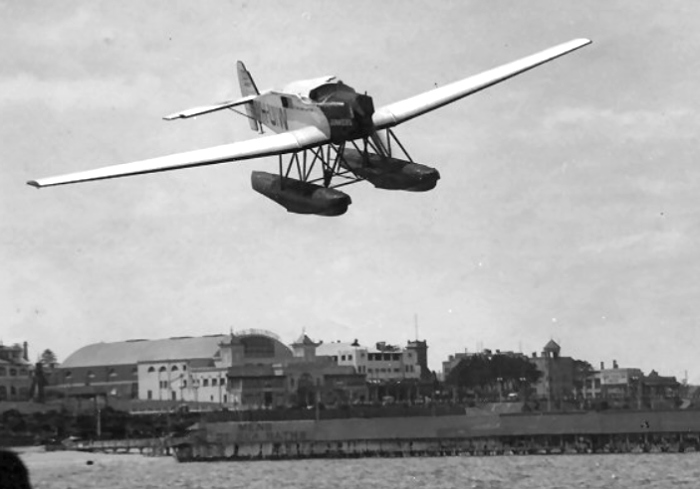
VH-UIW as a floatplane during water trials at St Kilda beach Melbourne February 1930.
This and the following picture came from Junkers agent H.J.Berryman, courtesy his grandson Hugh Batters.
This and the following picture came from Junkers agent H.J.Berryman, courtesy his grandson Hugh Batters.

Refuelling at Hamilton on the Brisbane River during the 1930 delivery flight from Melbourne to New Guinea

Pacific Aerial Transport's VH-UIW in New Guinea on wheels, Ray Parer (left) and his brother Kevin Parer.
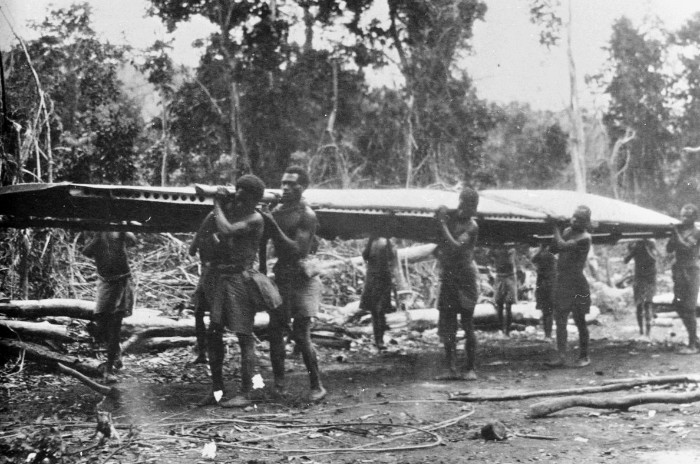
Although the circumstances involving the grounded VH-UIW being moved to the Alexishafen Catholic Mission remain
unknown, this and the next picture show a wing being carried by natives and the fuselage at the mission airstrip.
Photos: Civil Aviatiion Historical Society Ian Graboswsky collection
unknown, this and the next picture show a wing being carried by natives and the fuselage at the mission airstrip.
Photos: Civil Aviatiion Historical Society Ian Graboswsky collection

Confusion over the identity of the Junkers wreck at Alexischhafen can be clarified by this picture clearly showing VH-UIW.
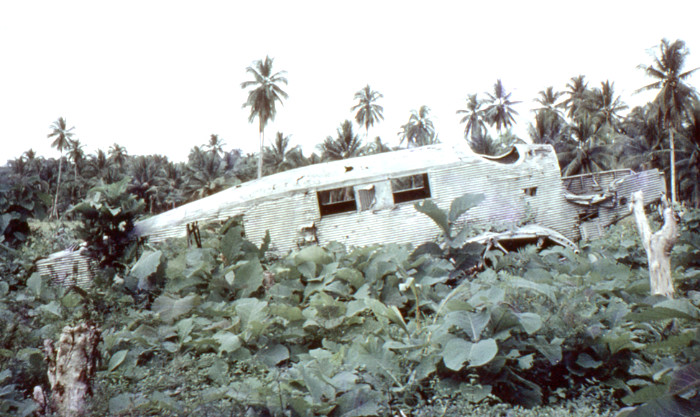

This and the previous picture show torn metal skinning below the engine mounts on both sides.
| Built under licence by Junkers' Swedish subsidiary company AB Flygindustri at Linhamm, Malmo Junkers W 33/34f, c/n 2702 One 420hp Bristol Jupiter VI radial engine uncowled |
|
| Ordered new by Guinea Airways Ltd, Lae, Territory of Papua New Guinea |
|
| 1.11.30 |
Swedish CofA was issued in the Luftvardighetsbevis series for aircraft receiving Swedish CofA but no Swedish registration. This was a Junkers arrangement to cover foreign exports while Germany was not a member of ICAN, making German airworthiness certification unacceptable to Australia. Sweden was an ICAN member and Swedish certification was acceptable to the Australian Civil Aviation Branch. |
| Swedish CofA form erroneously quoted c/n as "1368" which was a production batch number. The Australian Civil Aviation Branch used 1368 as this aircraft's identity. |
|
| Shipped from Hamburg to New Guinea on board SS Temerairie, which also carried Junkers G.31 VH-UOU. They were accompanied by Guinea Airways engineer Gustav Mueller who had been receiving training on the G.31 at the Junkers works. | |
| 29.12.30 |
SS Temerairie arrived Lae. Both Junkers were unloaded and moved to Lae airfield for assembly by Guinea Airways Ltd. |
| 9.1.31 |
Test flown at Lae after assembly. Civil Aviation Branch, Melbourne gave approval to commence operations pending formal certification. |
| 1.31 |
Undercarriage collapsed during landing at Bulolo, pilot Bob Gurney |
| 18.2.31 |
Crashed Bulolo during landing, swung off strip demolishing the undercarriage. Serious damage but pilot E.F.Selk was unhurt. Repair on site supervised by Guinea Airways engineer Sid Marshall. |
| 25.3.31 |
Registered VH-UOX: Guinea Airways Ltd, Lae, New Guinea. Quoted identity "1368". Fleet Number "Junkers 5" |
| 25.3.31 |
Australian CofA issued. Clerical exercise by CAB Melbourne: the aircraft at that time was in fact far from airworthy, undergoing repair from the 18.2.31 accident. |
| 11.31 |
Returned to service after major rebuikd |
| 6.34 |
Bristol Jupiter engine replaced by P&W Hornet radial engine. |
| 3.35 |
Commenced
several month's aerial survey and supply work, flown by Aubrey Koch on
charter to the British Papuan Concessions Ltd expedition searching for
gold. Took part in the aerial search for expedition pilot Stuart
Campbell when he went missing in his Short Scion floatplane G-ACUX along the Fly River during July 1935 |
| 25.5.36 |
Damaged landing at Slate Creek, New Guinea, rolled into creek after landing. Pilot Geoff Hemsworth |
| 10.9.36 |
Port undercarriage collapsed landing at Slate Creek, New Guinea, pilot Aub Koch |
| 12.4.37 |
Starboard undercarriage collapsed while taxying at Lae, pilot Les Ross |
| 8.9.38 |
Tailplane damaged at Salamaua, struck by landing Guinea Airways DH.83 Fox Moth VH-UQU flown by Eric Chater. The Fox Moth had skidded on wet boggy surface. |
| 14.1.39 |
Damaged landing at Lae, port undercarriage collapsed during landing roll, pilot Norman D.Fader |
| 9.2.39 |
Crashed during landing at Wau, struck rough ground on airfield when engine failed on approach. Pilot W.John Robins unhurt. |
| 17.10.40 |
Starboard undercarriage collapsed landing at Dumpu, Ramu Valley, New Guinea, pilot Leslie H.Ross |
| 12.41 |
Took part of air evacuation of civilians from Finschhafen to Lae ahead of Japanese advances |
| 1.42 |
Took part of air evacuation of civilians from Lae and Wau |
| 7.2.42 |
Impressed by Australian Government for RAAF use. |
| 5.3.42 |
Taken on RAAF strength as A44-2. Received No.24 Squadron Townsville ex Guinea Airways. (24 Squadron operated Hudsons and Wirraways and had been recalled to Townsville from Rabaul after losing 8 Wirraways to enemy action at Rabaul during February 1942) |
| 17.4.42 |
Now with No.33 Squadron Townsville. Allotted Guinea Airways Parafield Aerodrome, Adelaide for overhaul ex 33 Squadron (33 Squadron was established in February 1942 at Townsville as a transport unit to operate ex-Qantas Short Empire flying boats to carry military supplies to New Guinea and bring back wounded servicemen. Initially it also had an assortment of landplanes: Dragons, Tiger Moths, Ansons) |
| 9.5.42 |
Unserviceable at 33 Squadron |
| 22.5.42 |
Awaiting shipment to Mackay |
| 30.5.42 |
Shipped to Port Adelaide on SS Allana. |
| Overhaul by Guinea Airways Ltd at the airline's Adelaide base at Parafield Aerodrome. |
|
| 10.11.42 |
Received No.1 Aircraft Depot Laverton ex Guinea Airways, Parafield |
| 12.11.42 |
A44-2 and A44-3 (VH-UNM) held by 1AD unservicable for indefinite period |
| 16.6.43 |
Approval for conversion to components by 1AD Laverton |
| Engine and useful parts removed then broken-up for scrap metal. |

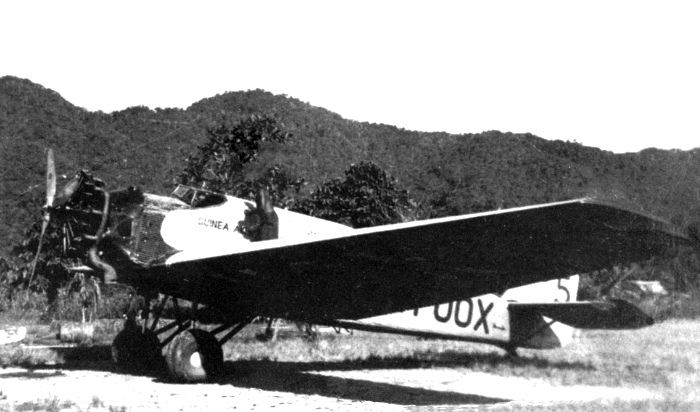
This view shows the P&W Hornet radial engine installation. Fred Niven collection

VH-UOX
with a gathering of New Guinea tribesmen
Ben Dannecker collection

Accident scene at Slate Creek after the port undercarriage collapsed 10 September 1936, pilot Aub Koch was unhurt
and went on to fly Short Empire flying boats for Qantas. Photo: South Austraklian Aviation Museum
and went on to fly Short Empire flying boats for Qantas. Photo: South Austraklian Aviation Museum

| Built under licence by Junkers' Swedish subsidiary company AB Flygindustri at Linhamm, Malmo. Junkers W 34b, c/n 2601 One 420hp Bristol Jupiter VI radial engine uncowled |
|
| Ordered by Guinea Airways Ltd, Lae, Territory of Papua New Guinea | |
| 24.12.27 |
Registered in Germany as D-1294 Junkers Flugzeugwerke A.G. |
| 12.27 |
Guinea
Airways senior pilot E.A. "Pard" Mustar visited the Junkers works at
Dassau to test fly the aircraft and finalise payment. He made
several flights to confirm that the aircraft could lift a ton of
payload, as per Guinea Airways specification. |
| 12.27 |
Purchase
included landplane undercarriage and a set of floats which were packed
in wooden cases with the dismantled aircraft for shipping |
| 12.27 |
Swedish CofA was issued in the Luftvardighetsbevis series for aircraft receiving Swedish CofA but no Swedish registration. This was a Junkers arrangement to cover foreign exports while Germany was not a member of ICAN, making German airworthiness certification unacceptable to Australia. Sweden was an ICAN member and Swedish certification was acceptable to the Australian Civil Aviation Branch. |
| 1.28 |
Shipped ex Hamburg to Rabaul, New Britain. |
| 20.3.28 |
Ship reached Rabaul. |
| Assembled with floats on the beach at Rabaul. |
|
| 20.3.28 |
Registered G-AUGZ Guinea Airways Ltd, Salamaua, later Lae, New Guinea |
| 10.4.28 |
Test flown on floats at Rabaul by Pard Mustar |
| 11.4.28 |
Departed Rabaul on floats on delivery to Guinea Airways' base at Lae, flown by Pard
Mustar acompanied by Guinea Airways engineer E.R.Chambers. Reached
Salamaua that day after a stop enroute at Lindenhafen harbour, New
Britain to refuel from fuel drums carried on board. |
| 12.4.28 |
Salamaua-Lae.
Mustar brought the floatplane on to the beach at the end of the Lae
airstrip. The wings were removed, floats replaced by the landplane
undercarriage. The aircraft was then moved on its wheels to the aistrip
where the wings were reattached. |
| 14.4.28 |
First commercial flight, Pard Mustar carried 2,300 lbs freight and 2 passengers to Wau. |
| 12.28 |
By the end of the year G-AUGZ had carried over 500 passengers and 300 tons of freight, earning revenue that saved Guinea Airways from shutting down following the loss of its earlier biplanes. |
| 1.29 |
Having
made 400 flights, commenced a major inspection at Lae by Junkers
engineer Gustav Mueller, who was seconded to Guinea Airways. Replaced in service by W.34 G-AUJD which had just arrived at Lae. |
| .29 |
Reregistered VH-UGZ when Australian aircraft nationality markings changed to VH- . Junkers Fleet No.1 |
| 12.29 |
Damaged when swung violently during landing at Wau in heavy mist. Pilot E.F.Selk. |
| 2.30 |
Flew a 400 lbs (180 Kg) metal casting to
Wau to prove Guinea Airways' capability to fly in suitably dismanted
components to assemble heavy gold mining machinery at the highlands
goldfields. |
| 6.3.30 |
Crashed on landing approach to Wau, New Guinea. Aircraft stalled on approach to land while carrying a full load of bottled beer to the Wau Hotel. Came to rest vertically, nose down among tall trees, pilot Rex Boyden minor injuries. |
| 30.6.30 |
Stuck-off Civil Register |

The aircraft's identity is confirmed by this enlargement of the tail showing c/n (Werk Nummer) 2601
Charles D. Pratt photographs courtesy Kevin O'Reilly collection

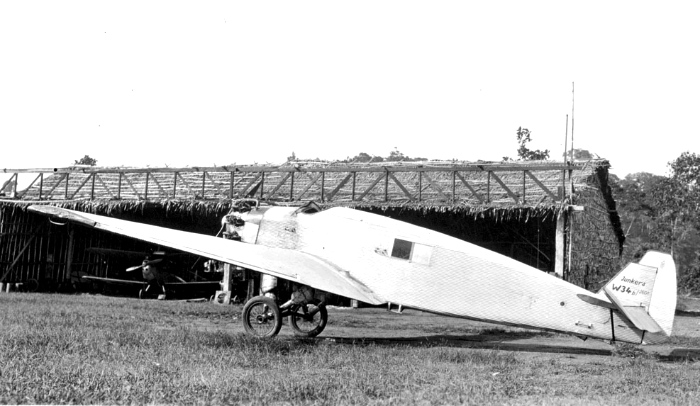
G-AUGZ at Lae now fitted with landplane undercarriage, but prior to having the Australian registration applied.
Photo by Charles D. Pratt, whose DH.60 Moth G-AUHJ can be seen in the hangar behind.
Photo by Charles D. Pratt, whose DH.60 Moth G-AUHJ can be seen in the hangar behind.
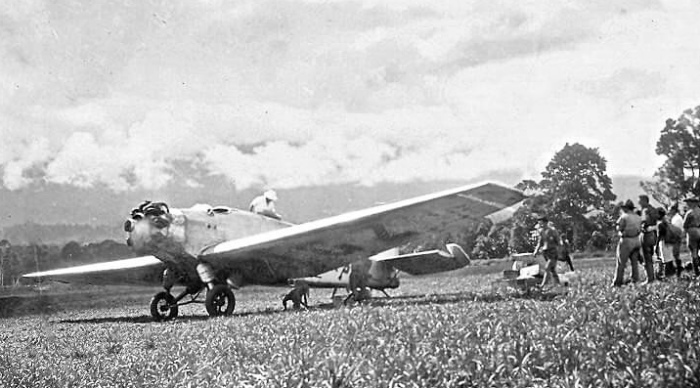
| .28 |
Built under licence by Junkers' Swedish subsidiary company AB Flygindustri at Linhamm, Malmo. Junkers W 34b, c/n 2604 One 425 hp Bristol Jupiter VI radial engine uncowled |
| 6.28 |
Ordered by Guinea Airways Ltd, Lae. New Guinea |
| Swedish CofA was issued in the Luftvardighetsbevis series for aircraft receiving Swedish CofA but no Swedish registration. This was a Junkers arrangement to cover foreign exports while Germany was not a member of ICAN, making German airworthiness certification unacceptable to Australia. Sweden was an ICAN member and Swedish certification was acceptable to the Australian Civil Aviation Branch. |
|
| Shipped
to Australia, unloaded in Melbourne. At that time few large ships
called at New Guinea due to low demand because of the limited
development. |
|
| 11.28 |
Assembled
at RAAF Point Cook, near Melbourne and fitted with the floats previously
used by G-AUGZ. The floats set had been shipped from Lae to to Melbourne for this second Junkers. |
| 4.12.28 |
Registered G-AUJD: Guinea Airways Ltd, Lae, New Guinea Fleet Number "Junkers No.2" |
| 13.12.28 |
Departed Point Cook for a 6 day delivery flight to New Guinea as a floatplane, flown by
Guinea Airways senior pilot E.A. Pard Mustar, with company engineer
A.C.McMurtrie . Mustar took a coastal route, landing on sheltered
waters to refuel from small fuel drums carried in the aircraft's cargo
hold: Sydney (Rose Bay),Southport, Gladstone, Bowen, Cooktown, Thursday
Island, Daru, Port Moresby, Samarai. Reached Lae 21.12.28 |
| 21.12.28 |
On arrival Lae the floats were quickly removed and replaced by landplane undercarriage. Civil Aviation Branch, Melbourne cabled approval to commence operations. |
| 19.12.28 |
Australian CofA issued. Issued retrospectively several months later by CAB in Melbourne, based on receipt of a Guinea Airways engineer's inspection report on arrival at Lae. At that time CAB had no staff stationed in New Guinea and mail to Australia was carried by sea. |
| 11.29 |
Minor damage landing Upper Watut, pilot E.F. Selk |
| .29 |
Reregistered VH-UJD when Australian aircraft nationality markings changed to VH- . |
| 28.4.30 |
CAB inspection report at Lae, total airframe time 1265 hours. |
| 17.1.31 |
Badly damaged when undercarriage collapsed during landing at Bulolo New Guinea. Pilot C.R. Gurney unhurt. |
| Damaged
aircraft was dismantled into sections which were flown to Lae as
back-loading by the Junkers G31s. The wings, which would not fit
througn the G31 roof loading hatch, were carried by native labourers
overland
to Lae. Rebuild commenced in the Guinea Airways hangar at Lae airfield
but abandoned because of the extent of damage. |
|
| 2.11.31 |
Last entry in DCA file: Guinea Airways Lae letter to CAB Melbourne: "VH-UJD
is not at present in use but is being rebuilt and is expected to be
finished about the end of December. As soon as this is done we shall
re-apply for a renewal of the Certificate of Airwhorthiness. " |
| Damage was beyond economical repair at Lae. Used for spare parts. |


| .29 |
Built under licence by Junkers' Swedish subsidiary company AB Flygindustri at Linhamm, Malmo. Junkers W 34d, c/n 2610 One 420hp Bristol Jupiter VI radial engine uncowled |
| Ordered new by Guinea Airways Ltd, Lae, Territory of Papua New Guinea Airframe with fittings for a Jupiter engine, but engine not included in purchase. |
|
| 27.8.29 |
Swedish CofA was issued in the Luftvardighetsbevis series for aircraft receiving Swedish CofA but no Swedish registration. This was a Junkers arrangement to cover foreign exports while Germany was not a member of ICAN, making German airworthiness certification unacceptable to Australia. Sweden was an ICAN member and Swedish certification was acceptable to the Australian Civil Aviation Branch. |
| Shipped to New Guinea. Shipping schedules now allowed it to be unloaded at Lae harbour |
|
| 12.29 |
Assembled
at Lae by Guinea Airways. Civil Aviation Branch in Melbourne cabled
approval to commence flying pending formal certification |
| 6.12.29 |
Entered service at Lae |
| 5.1.30 |
Undercarriage collapsed on landing at Wau, major damage, pilot E.F.Selk |
| 5.3.30 |
Registered VH-UNM Guinea Airways Ltd, Lae, New Guinea Fleet Number "Junkers No.3" |
| 5.3.30 |
Australian CofA issued. 8 passenger seats or freighter |
| 26.9.30 |
Swung violently during landing at Lae, undercarriage wrecked, pilot Frank Dayton. Repaired in 8 days |
| 7.10.30 |
Frank Dayton flew VH-UNM to Bulolo to collect Guinea Airways pilot W.P.Wiltshire who had crashed DH.60 Moth VH-UHJ while landing there in strong winds. |
| 26.2.31 |
Forced landing on grassed area near Snake River, no airframe damage, pilot Bob Gurney. Aircraft was out of service for 10 days until the engine was repaired and flown out. |
| 8.32 |
Modified from freighter to passenger cabin at Lae: seating for 8 passengers and cabin windows installed. Replaced Junkers F.13 VH-UKW during an overhaul and engine change. VH-UNM flew the Port Moresby-Wau scheduled service and many passenger charters betwen the goldfields and Port Moresby. |
| 6.2.33 |
Damaged in forced landing near Lae when engine failed. Pilot Orm Denny unhurt |
| 8.3.33 |
Commenced
an extensive survey for the New Guinea Administration to take patrol
officers to unexplored territory, pilot Ian Grabowsky. It was the first New Guinea overland expedition to rely on air supply. |
| 10.34 |
Re-engined with a 500hp P&W Hornet radial engine uncowled |
| 26.1.35 |
Damaged, swung off strip and struck trees landing at Evei, Kokoda. Pilot Orm Denny unhurt Extensive damage, under repair until late April 1935. |
| 10.36 |
Fitted
with floats at Lae,
using the same float set stored since 1928 when used to ferry the first
W23 from Melbourne. It was a hard-worked aeroplane but there was no
time for an overhaul before commencing a two year contract to support
land expeditions by Papuan Oil
Development Company. Pilot Aub Koch agreed to be the initial pilot |
| 10.12.36 |
Flown
by pilot Koch with engineer Carl Isler from Port Moresby to the Fly
River expedition campsite to commence the contract, which continued to
April 1937. |
| 4.37 |
Operated as floatplane to supply an Investors Ltd gold search up Strickland River, Sepik District, pilots Koch and engineer Isler. |
| 6.5.37 |
Commenced a floatplane contract for Island Exploration Company |
| 37 |
Operated on floats on contract with Fly River Oil Exploration Company. |
| 19.10.37 |
Commenced a floatplane contract to carry supplies to a newly established Government and Police Station at Lake Kuttabu.
Pilot Aubrey Koch departed Kikori with the first load of supplies,
taking experienced patrol officer Ivan Champion as a guide. Returned
due engine trouble. Departed Kikori again 21.10.37 and successfully
landied on the water at Lake Kittabu. The station was dependent on air supply for the next three years until it was closed during 1940. |
| 2.40 |
Based on floats at Port Moresby, being operated for RAAF Survey Flight |
| 10.2.42 |
Taken over by RAAF at Horne Island, Queensland after an evacuation flight from New Guinea following the Japanese air raids. |
| 10.2.42 |
Impressed by Australian Government for RAAF use, Impressment No.9035. |
| 24.3.42 |
Taken on RAAF charge as A44-3. Aircraft on floats, located Townsville Qld |
| 31.3.42 |
Issued to RAAF Rathmines NSW seaplane station |
| 15.11.42 |
Received 1AD Laverton Victoria ex Rathmines |
| 19.11.42 |
A44-3 and A44-2 (VH-UOX) held by 1AD unservicable for indefinite period |
| 16.6.43 |
Approval for conversion to components by 1AD Laverton |
| Engine and useful parts removed then broken-up for scrap metal. |
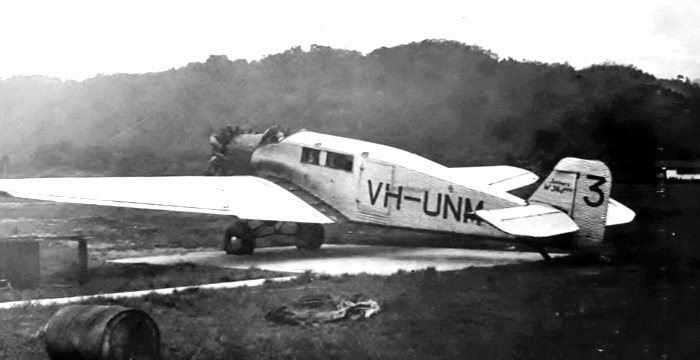
Guinea Airways "Junkers No.3" in New Guinea. Greg Thom collection
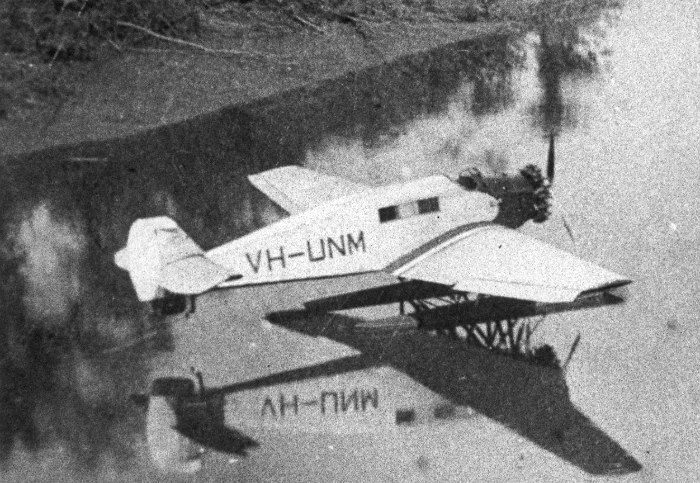
During October 1937 Guinea Airways fitted VH-UNM with floats.
Frank Walters Collection


VH-UNM at a slipway in Port Moresby harbour 24 February 1940 while
being used by RAAF Survey Flight.
Photo: Australian War Memorial
Photo: Australian War Memorial


| 29 |
Built under licence by Junkers' Swedish subsidiary company AB Flygindustri at Linhamm, Malmo. Junkers W 34d, c/n 2611 One 420hp Bristol Jupiter VI radial engine uncowled |
| Ordered by Guinea Airways Ltd, Lae, Territory of Papua New Guinea Airframe with fittings for a Jupiter engine, but engine not included in purchase. |
|
| 31.12.29 |
Swedish CofA was issued in the Luftvardighetsbevis series for aircraft receiving Swedish CofA but no Swedish registration. This was a Junkers arrangement to cover foreign exports while Germany was not a member of ICAN, making German airworthiness certification unacceptable to Australia. Sweden was an ICAN member and Swedish certification was acceptable to the Australian Civil Aviation Branch. |
| Shipped from Hamburg to Australia on SS Mosel
accompanied by German engineers P.Walther and E.W.Haynes recruited by
Guinea Airways. Also on board was Junkers W33 VH-UIW. At that time few large ships called at New Guinea due to low demand because of the limited development. |
|
| 7.2.30 |
SS Mosel arrived Melbourne where Junkers W33 VH-UIW was off-loaded. The ship continued to Sydney where VH-UNR was transferred to anothee vessel for Lae. |
| 7.3.30 |
Reached Lae by sea. |
| 31.3.30 |
Registered VH-UNR Guinea Airways Ltd, Lae, New Guinea Fleet Number "Junkers No.4" |
| Assembled by Guinea Airways at Lae, Bristol Jupiter VI engine from spares stock installed. Civil Aviation Branch in Melbourne cabled approval to enter service pending formal certification |
|
| 2.6.30 |
Australian CofA issued. Freighter only. |
| 2.8.30 |
Damaged
in forced landing in swampy country near Snake Valley, Morobe District,
when the engine seized enroute Lae-Wau. Pilot E.F.Selk. Undercarriage
torn away. |
| 10.30 |
Retured to service after repairs |
| 1.5.31 |
CofA renewed after repair |
| 22.5.31 |
Destroyed, struck mountain near Wampit. Pilot Leslie J. Trist was carrying 1,831 pounds of cargo from Lae to Bulolo, but did not arrive. Posted as missing, a lengthy aerial and ground search was unsuccessful. |
| 13.8.31 |
Wreckage
located by tribal natives, pilot had been killed instantly. Natives
took the pilot's head to Lae airfield where it was identified as Les
Trist. |
| 8.31 |
Guinea
Airways Manager Alan Cross with a ground party accompanied the natives
back to the crash site to recover aircraft parts. The impact was so
severe that nothing could be salvaged. The pilot's remains were recovered to be later buried at Waverley Cemetery in Sydney. |
| A lake near the crash site was named Lake Trist in the pilot's honour. |
| 30 |
Built at Dessau by Junkers Flugzeug und Motorwerke A.G. Junkers G 31go, c/n 3011 Three BMW German built 500hp Pratt & Whitney Hornet A2 radial engines uncowled |
| 22.5.30 |
Ordered by Bulolo Gold Dredging Ltd, Bulolo New Guinea. Order for two G.31s freighter models with a 142 x 60 inch removable hatch in the roof, passenger windows replaced by four portholes, open cockpit, plus spare parts and 9 P&W Hornet A2 engines. |
| 26.9.30 |
Swedish CofA was issued in the Luftvardighetsbevis series for aircraft receiving Swedish CofA but no Swedish registration. This was a Junkers arrangement to cover foreign exports while Germany was not a member of ICAN, making German airworthiness certification unacceptable to Australia. Sweden was an ICAN member and Swedish certification was acceptable to the Australian Civil Aviation Branch. |
| Packed in 8 crates and shipped to New Guinea on board SS Temerairie, which
also carried Guinea Airways Junkers W33/34f VH-UOX. Accompanied by
Junkers engineer Gustav Mueller, returning for another attachment to
Guinea Airways. |
|
| 29.12.30 |
SS Temerairie arrived Lae. Both Junkers were unloaded and moved to Lae airfield for assembly by Guinea Airways. |
| 1.31 |
Assembled and test flown at Lae. Civil Aviation Branch approval to commence operations pending formal cerification by Head Office Melbourne. |
| 31.3.31 |
Guinea Airways' Lae Manager Alan Cross flew VH-UOU Lae-Bulolo for the first G.31 landing on the improved airfield at Bulolo. |
| 25.5.31 |
Registered VH-UOU Guinea Airways Ltd, Lae, New Guinea Fleet Number "Bulolo 1", named 'Paul" |
| 25.5.31 |
Australian CofA issued |
| .32 |
Ownership changed to: Bulolo Gold Dredging Ltd, Bulolo New Guinea, operated by Guinea Airways Ltd, Lae, New Guinea |
| 25.8.32 |
Damaged on takeoff Bulolo, port engine power loss, swung off strip. Pilot H. McGilvrey |
| 11.32 |
Returned to service after repair. By now the first two G.31s VH-UOU & UOV had operated 1,370 flights uplifting 3,657 tons of freight. |
| 1.5.34 |
Crashed
on takeoff Lae carrying a mixed cargo including 44 gallon drums of oil
and fuel. As the aircraft taxied over the rough airfield surface,
several fuel drums broke loose and rolled to the rear of he cabin,
which put the Centre of Gravity
beyond the rear limit. During takeoff pilot Bert Heath lost control but
managed a
heavy landing on the airfield, demolishing the undercarriage and
causing serious structural damage. Pilot and flight engineer M.Headland
were not hurt. The three P&W Hornet engines and propellers from the badly damaged VH-UOU were removed and installed in the newly-arrived Junkers G 31 VH-URQ ordered without power plants. VH-URQ was then put into service to replace VH-UOU during its long rebuild. |
| Guinea Airways engineer Gustav Mueller was sent by sea to the Junkers works in Germany to acquire necessary parts and bring back Junkers ground engineers to assist the rebuild. | |
| 12.34 |
Muller
arrived back at Lae by ship from Germany, bringing 3 Junkers engineers,
tooling and airframe components. While out of service, VH-UOU's three engines were installed in Guinea Airways G.31 VH-URQ. |
| 16.12.35 |
CofA renewed after rebuild at Lae |
| 5.36 |
Damaged landing at Slate Creek, rolled into the creek. |
| 4.37 |
Undercarriage damaged during landing at Lae |
| 2.39 |
Undercarriage damaged during landing at Lae |
| 10.40 |
Undercarriage damaged during landing at Lae |
| 30.9.41 |
CofA expired. Retired at Bulolo pending a complete overhaul. |
| 21.1.42 |
Destroyed by Japanese air attack on Bulolo airfield, New Guinea. While being refuelled at Bololo, struck by incendary bullets from stafing fighters and burnt out. Other aircraft destroyed in the same raid included G.31s VH-UOV and VH-URQ. No casualties. |
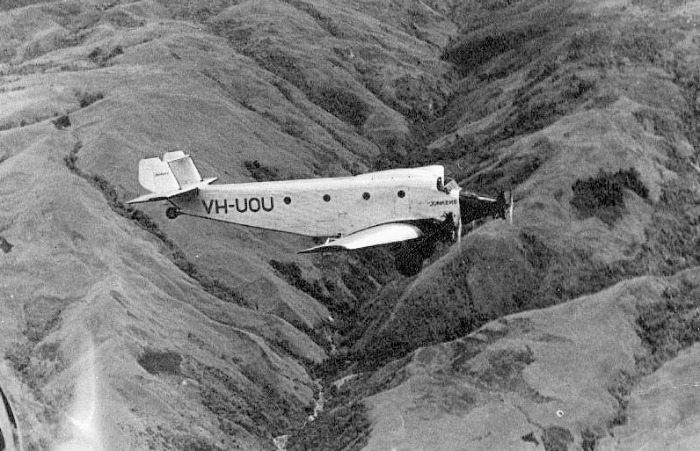

VH-UOU
at Wau unloading a truck chassis.
Civil Aviation Historical Society
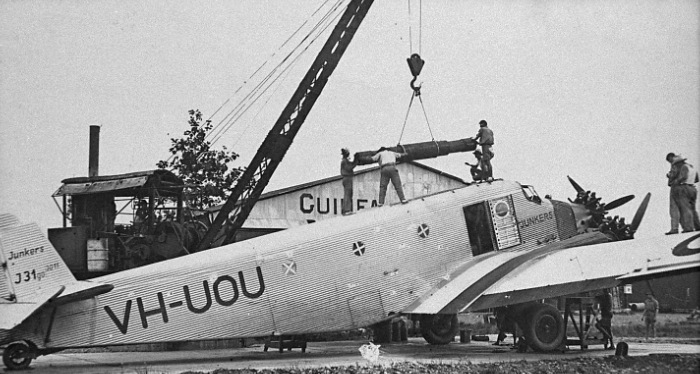
Loading at Lae. Names were not painted on the right side but the tail has the factory markings "Junkers J31go 3011"
John Hopton Collection
John Hopton Collection
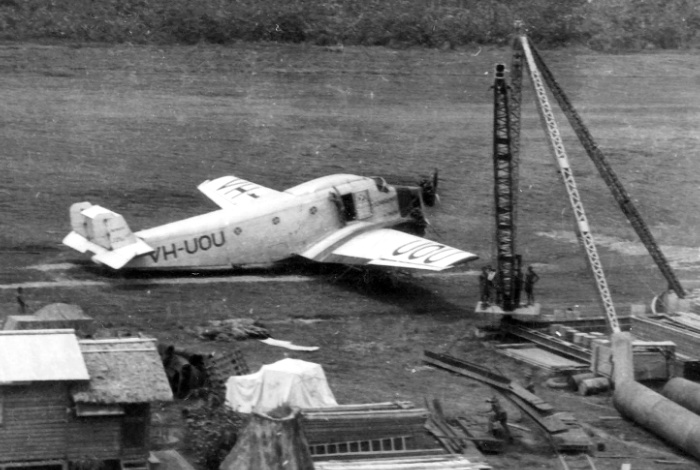
The Bulolo airfield loading and unloading crane mounted on rail tracks. Civil Aviation Historical Society
| 30 | Built at Dessau by Junkers Flugzeug und Motorwerke A.G. Junkers G 31go, c/n 3012 Three BMW German built 500hp Pratt & Whitney Hornet A2 radial engines uncowled |
| 22.5.30 |
Ordered by Bulolo Gold Dredging Ltd, Bulolo New Guinea. Order for two G.31s freighter models with a 142 x 60 inch removable hatch in the roof, passenger windows replaced by four portholes, open cockpit, plus spare parts and 9 P&W Hornet A2 engines. |
| 10.11.30 |
Swedish CofA was issued in the Luftvardighetsbevis series for aircraft receiving Swedish CofA but no Swedish registration. This was a Junkers arrangement to cover foreign exports while Germany was not a member of ICAN, making German airworthiness certification unacceptable to Australia. Sweden was an ICAN member and Swedish certification was acceptable to the Australian Civil Aviation Branch. |
| 1.31 |
Junkers G.31s VH-UOV & UOW shipped from Hamburg to New Guinea packed in crates on board the same ship. |
| 12.2.31 |
Ship arrived Lae. Both Junkers were unloaded and moved to Lae airfield for assembly by Guinea Airways. |
| 2.5.31 |
Test
flight Lae after assembly. Civil Aviation Branch approval to
commence operations pending formal cerification by Head Office Melbourne |
| 6.5.31 |
Entered service, first trip Lae-Bulolo-Lae |
| 10.6.31 | Registered VH-UOV Bulolo Gold Dredging Ltd, Bulolo New Guinea, operated by Guinea Airways Ltd, Lae, New Guinea Fleet Number "Bulolo No.2", named 'Peter" |
| 10.6.31 | Australian CofA issued |
| 10.32 |
The first two G.31s VH-UOU & VH-UOV had operated 1,370 flights uplifting 3,657 tons of freight. |
| 7.5.37 |
Port wing damaged when struck by propeller of taxying DH.50 owned by Stephens Air Service, pilot H.D.McGilvery |
| 23.8.37 |
Roof
badly damaged at Wau when a cargo item being lifted by crane through
the open roof hatch slipped and struck the aircraft's roof. |
| 1.42 |
Evacuated civilians from Salamaua to Australia ahead of Japanese advances in the Pacific. |
| 21.1.42 | Destroyed by Japanese air attack on Bulolo airfield, New Guinea. While being refuelled at Bololo, struck by incendary bullets from stafing fighters and burnt out. Other aircraft destroyed by the same raid included G.31s VH-UOU and VH-URQ. No casualties. |

Junkers
G31 VH-UOV at the Guinea Airways base at Lae airfield, New
Guinea. South Australian Aviation Museum


Desperate times. Evacuating civilians at Salamaua during January 1942 ahead of advancing Japanese forces.
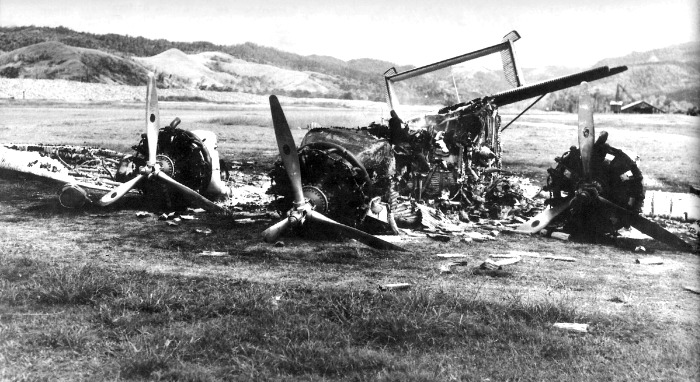
Fred Niven collection
| 30 |
Built at Dessau by Junkers Flugzeug und Motorwerke A.G. Junkers G 31go, c/n 3010 Three BMW German built 500hp Pratt & Whitney Hornet A2 radial engines uncowled |
| 10.30 |
Ordered by Guinea Airways Ltd, Lae New Guinea. Same freighter specifications as the preceeding two G.31s VH-UOU & VH-UOV which Guinea Airways were operating on behalf of Bulolo Gold Dredging Company. |
| 2.12.30 |
Swedish CofA was issued in the Luftvardighetsbevis series for aircraft receiving Swedish CofA but no Swedish registration. This was a Junkers arrangement to cover foreign exports while Germany was not a member of ICAN, making German airworthiness certification unacceptable to Australia. Sweden was an ICAN member and Swedish certification was acceptable to the Australian Civil Aviation Branch. |
| 1.31 |
Junkers G.31s VH-UOV & VH-UOW shipped from Hamburg to New Guinea packed in crates. |
| 12.2.31 |
Ship arrived Lae. Both Junkers were unloaded and moved to Lae airfield for assembly by Guinea Airways. |
| 5.31 |
Test flown Lae after assembly. Civil Aviation Branch gave approval to commence operations pending formal certification by Head Office Melbourne |
| 10.6.31 |
Registered VH-UOW Guinea Airways Ltd, Lae, New Guinea Allotted name "Gnair" (Guinea Airways telegraphic address) but it was not painted on the aircraft |
| 10.6.31 |
Australian CofA issued |
| 11.2.33 |
Accident on takeoff Wau:
during takeoff run down the steeply sloping strip, the port engine failed, aircraft swung off strip. Pilot Ian Grabowsky cut power to the remaining two engines, but to avoid rolling over the edge of the airfield down into a creek, rolled
into a house being built for fellow company pilot Orm Denny near the
Guinea Airways office and freight shed. The house as demolished 3 new propellers and a replacement port engine were flown in from Lae and engineers repaired damaged skin and bent port undercarriage strut. |
| 27.3.33 |
Broke
world record for air freight when pilot Ian Grabowsky made six return
flights in one day between Lae and Wau carrying 33,360 lbs of gold dredge components. |
| 2.9.41 |
Damaged at Wau, ground-looped during takeoff and ran off strip. Pilot G.H.Jackson unhurt. Quickly repaired. |
| 21.1.42 |
Pilot
Les Ross was flying VH-UOW from Wau to Salamaua when he saw the
Japanese air raid on Salamaua airfield in progress ahead, so returned
to Wau. Twelve civil aircraft and one RAAF aircraft were destroyed on
the ground at Salamua. |
| 22.1.42 |
Flown Wau-Lae to take part in the air evacuation of civilians from Lae to Port Moresby along with Guinea Airways Ford Trimotors VH-UBY & VH-UDY, pilots Tommy O'Dea, Les Ross and Bert Heath. |
| Authorities
ordered Guinea Airways to evacuate these three remaining trimotors to Australia carrying Guinea Airways staff.
That instruction attracted severe criticism that civilians were not
offered evacuation on these aircraft. Ford Trimotors VH-UDY, VH-UBI and Junkers UOW were initially to be left at RAAF Garbutt, Townsville in anticipation that they would be impressed by the Australian Government for military transport use. |
|
| 30.1.42 |
VH-UOW eached RAAF Laverton near Melbourne from New Guinea flown by a Guinea Airways crew carrying company staff and families. |
| 1.42 |
Impressed by Australian Government for RAAF use. Impressment Requisition No.9024 |
| 30.1.42 |
Taken on RAAF strength as A44-1. Three P&W Hornet T2/3 engines |
| 23.2.42 |
Received No.2 Communications Flight, Mascot ex 1AD Laverton |
| 28.1.42 |
Received 1AD Laverton ex 2CF |
| Maintained servicable at 1AD |
|
| 30.5.42 |
Fitted for ambulance duties |
| 19.10.42 |
Issued to 34 Squadron, Manbulloo strip NT ex 1AD |
| 19.10.42 |
Received 36 Squadron Essendon enroute to 34 Squadron. Directorate of Air Transport allocated transport radio callsign VHCRT but doubtful that it was painted on the aircraft prior to its crash later that month. |
| 19.10.42 |
Carried a load of refrigeration rquipment from Melbourne to Darwin, flown by 36 Sqn Flying Officer J.L.D.Whiteman and copilot Pilot Officer Peter Lavarack. Carried
wounded airmen on the return flight from Darwin to Melbourne, diverting
enroute to Cootamundra with engine trouble. Continued to 1AD Laverton |
| 31.10.42 |
Crashed on takeoff Essendon Aerodrome, Melbourne Vic. Test flight by Pilot Officer Peter Lavarack after engine repairs, starboard engine failed, aircraft ran off the runway striking a vehicle. Undercarriage wrecked, both wings badly damaged. |
| 3.11.42 |
Received No.1 Aircraft Depot, Laverton ex 36 Squadron Essendon |
| 5.11.42 |
Held by 1AD unservicable for indefinite period |
| 14.5.43 |
Approval for conversion to components by 1AD Laverton |
| RAAF Flight Leiutenant James "Wac" Whiteman recalled flying A44-1 from New Guinea to Melbourne in October 1942, via Darwin and Batchelor. The next flight to New Guinea was to be as an ambulance to aid the evacuation of wounded Australian troops from Lake Myola, but crashed at Essendon before departure. | |
| An
airman at RAAF Nhill recalled a Junkers trimotor landed at Nhill on its
way to Darwin carrying a load of fighter drop tanks. After refuelling,
one engine refused to start. The pilot ordered that the aircraft be unloaded and
then took off on two engines, climbed within sight of the airfield and
commenced a steep dive to turn the dead propeller which succesfully started the
reluctant engine. Compiler's note: sound like the actions of highly experienced prewar pilot James "Wac" Whiteman |
|
| Harry
Moss was a DCA aircraft engineeer at Essendon in 1942 working on a
DH.50 biplane VH-UAB which had been impressed by RAAF as A10-1. He was
replacing the Puma engine with a 450 hp P&W Wasp to give it the
performance to evacuate Australian troop casualties from the short
strip Lake Myola. When the military Directorate of Air Transport ruled
Lake Myola as unsuitable, DCA proposed using impressed civil aircraft
flown by experienced prewar New Guinea pilots. In his book !0,000 Hours, Captain Harry Moss, who went on to a long flying career, wrote: "Getting the wounded back to hospital in Port Moresby from the Kokoda Trail was a long and terrible job. There was an airstrip at Myola, 5000 feet up on the range and it was suggested they could be flown out from there. New Guinea aeroplanes flown by New Guinea pilots could do the job. There were appropriate machines in Melbourne: a Ford trimotor, a Junkers trimotor and my DH.50. The Junkers was being prepared by the RAAF. Lots of keen but very inexperienced young airmen were working on it. The P&W Wasp C fitted to these aeroplanes was undoubtedly best of the job but had to be sympathetically handled. Even when the engine as warm, the throttle had to be opened slowly and steadily to full power. The Junkers was to be ferried to New Guinea by a RAAF pilot. One day we heard its engines being warmed up for some time at the north end of Essendon aerodrome then opened up to full power. Tommy O'Dea, a seasoned New Guinea pilot who knew the Junkers well, and I went it our hangar door to see it go. We watched the Junkers charging down the runway with the starboard engine stopped. The big trimotor was swinging to the right towards the hangars. The starboard wing missed the control tower but hiut a big steel roller. The impact swung the aeroplane around and it went backwards through the boundary hedge and fence on to the road. Tommy and I were soon after it, with the fire wagon, but there was no fire. The beautiful aeroplane was on its belly, the corrugated aluminium skin mangled and crumpled. A write off." |
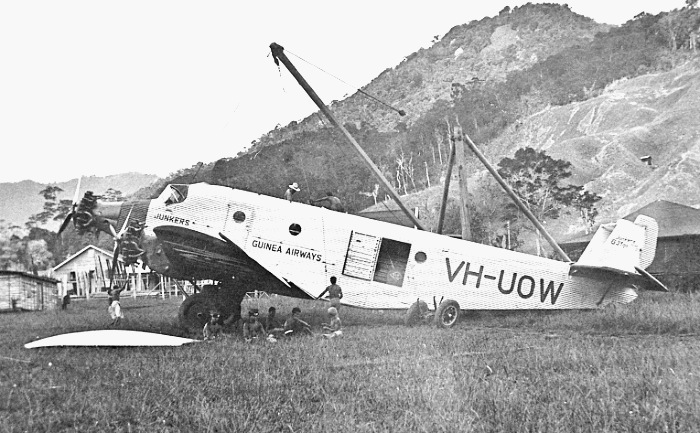
Guinea
Airways' own Junkers G31 VH-UOW at
Bulolo.
John Hopton Collection
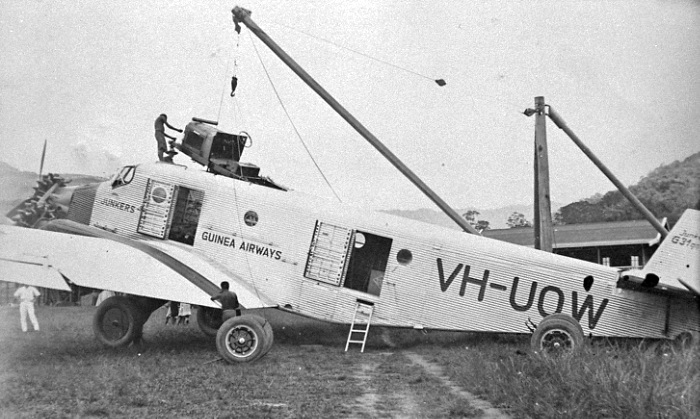

New
Guinea airfield scene: VH-UOW and Ray Parer's Junkers W.33 VH-UIW.
Frank Walters collection
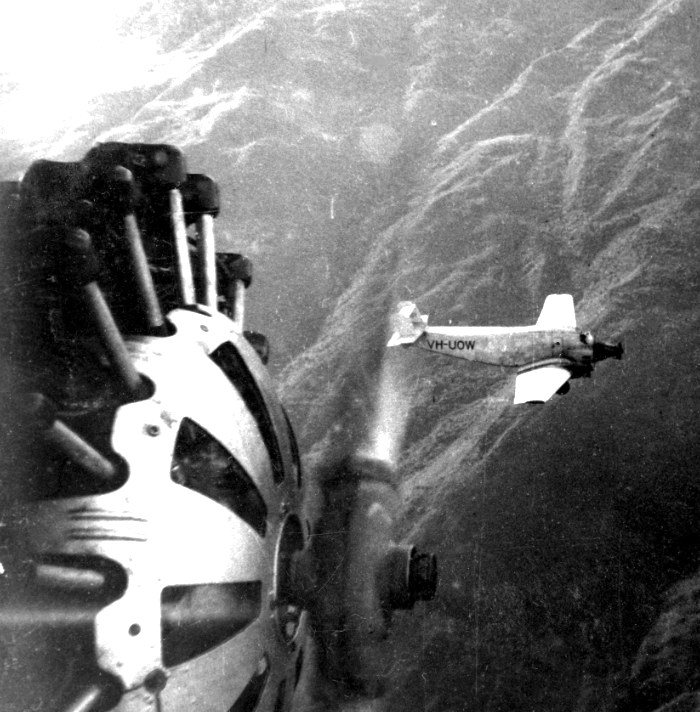
| .26 |
Built at Dessau by Junkers Flugzeug und Motorwerke A.G. as prototype new model G 31. This prototype large all metal trimotor airliner was designated Junkers G 31.1. c/n 3000 Initially powered by three Junkers L5 in-line engines. |
| 9.26 |
Registered D-1073 Junkers Flugzeug |
| 19.9.26 |
First test flght Dessau. Carried out flight testing for issue of German type CofA |
| Flight
testing revealed the Junkers L5 engines did not provide sufficient
power. To evaluate other power plants, the centre engine was replaced
by a BMW VI water cooled V12 engine, model designation G 31.2. With further refinements, this became the production model G 31ba |
|
| 33 |
An additional G 31 was ordered by Bulolo Gold Dredging Ltd, Bulolo New Guinea. The order was for an airframe configured for P&W Hornet engines, but without engines or propellers, which would be installed on arrival New Guinea from existing spares stock. |
| 33 |
The G.31 series was no longer in production. Junkers brought the prototype out of storage and modified it to the same freighter specification as the previous three G 31go models for New Guinea. |
| 17.11.33 |
Swedish
CofA was issued in the Luftvardighetsbevis series for aircraft
receiving Swedish CofA but no Swedish registration. Model quoted as
Junkers G 31ba. This was a Junkers arrangement to cover foreign exports while Germany was not a member of ICAN, making German airworthiness certification unacceptable to Australia. Sweden was an ICAN member and Swedish certification was acceptable to the Australian Civil Aviation Branch. |
| Shipped from Bremerhaven to New Guinea on board SS Bremerhaven |
|
| 1.34 |
Unloaded at Lae. Assembled by Guinea Airways at Lae airfield. Parked at Lae without engines because it was not immediately required in service. |
| 6.34 |
The
three P&W Hornet A2s from G 31 VH-UOU which crashed at Lae 1.5.34
were removed and installed in VH-URQ which entered service while UOU
was repaired. |
| 9.6.34 |
Registered VH-URQ Bulolo Gold Dredging Ltd, Bulolo New Guinea, operated by Guinea Airways Ltd, Lae, New Guinea Fleet Number "Bulolo 3", named 'Pat" |
| 9.6.34 |
Australian CofA issued |
| 6.7.34 |
After takeoff at Lae for a test flight to investigate the source of a vibration from the nose engine, a propeller blade detached from that engine. The centre engine was torn from its engine mounts
and the entire nose structure fell away, Pilot W.P. "Bill" Wiltshire was able to complete a circuit to land without further damage. Repairs completed within a week. |
| 10.9.34 |
The roof cargo hatch broke loose during takeoff at Lae on a flight to Bulolo. Captain Bert Heath was checking out new arrival Jack Turner.
The hatch struck the tailplane where it was held in place by the
airflow, making the aircraft difficult to handle. Heath diverted to the
Nadzab emergency landing ground, where he landed without damage. The hatch fell away during the landing roll. |
| 20.8.40 |
Crashed on takeoff Lae. All three engines failed
and during the forced landing struck tree stumps which tore away the
undercarriage and badly damaged the fuselage undersides. Investigation
found that the engine fuel controls had not been correctly set during
recent maintenance. |
| Repaired and returned to service |
|
| 21.1.42 |
Destroyed by Japanese air attack on Bulolo airfield New Guinea. VH-URQ had just landed and pilot Bert Heath had left the aircraft when fighters commenced stafing the airfield. It was struck by incendary bullets and destroyed by fire. No personnel casualties. |
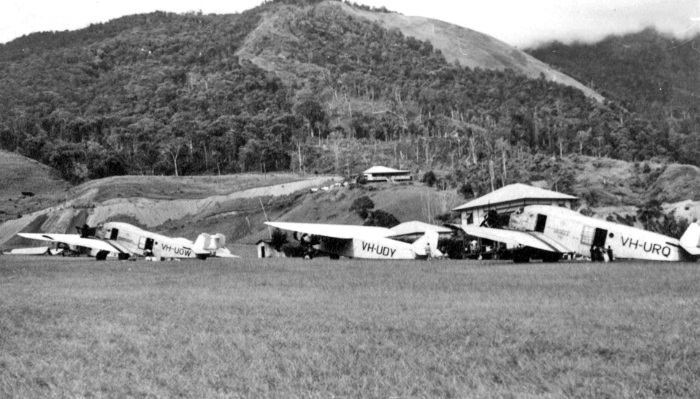
Photo: Civil Aviation Historical Society


Guinea Airways Stinson Reliant VH-URC crashed on takeoff at Wau in November 1937 and the wreck was sent to Lae
on board Junkers VH-URQ. Pictured being loaded at Wau, with Stephens Aviation DH.66 Hercules VH-UJP behind.
Civil Aviation Historical Society Len Dobbin collection
on board Junkers VH-URQ. Pictured being loaded at Wau, with Stephens Aviation DH.66 Hercules VH-UJP behind.
Civil Aviation Historical Society Len Dobbin collection
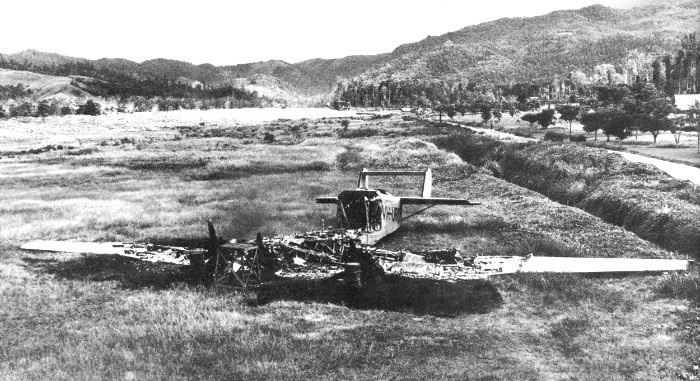
VH-URQ's remains at Bulolo after a Japanese air raid in January 1942. Fred Niven collection
| .30 |
Built at Dessau by Junkers Flugzeug und Motorwerke A.G. Junkers A 50 Junior, c/n 3517 One 88hp Armstrong Siddeley Genet Mk.2 radial engine uncowled |
| Swedish CofA was issued in the Luftvardighetsbevis series for aircraft receiving Swedish CofA but no Swedish registration. This was a Junkers arrangement to cover foreign exports while Germany was not a member of ICAN, making German airworthiness certification unacceptable to Australia. Sweden was an ICAN member and Swedish certification was acceptable to the Australian Civil Aviation Branch. |
|
| 2.3.36 |
Registered VH-UCC Percy T.Parker c/- Parker Brothers Automotive, Warrnambool Vic Named "Rena" after his wife. Australian civil registrations sequential issue had reached the VH-UV series by 1936, however the CAA was "back-filling", allocating earlier unused registrations. |
| 2.3.36 |
Australian CofA issued. |
| 6.47 |
Advertised for sale in Aircraft magazine: photo of VH-UCC: Junkers Junior A.50 all metal two seater, dual control sports plane. CofA current until 20 March 1948. Engine and airframe 238 hours total. Considerable quantity of engine and airframe parts: P. T. Parker, Parker Auto Co, Warrnambool Vic |
| 14.12.47 |
visited airshow at Fishermans Bend airfield, Melbourne Vic, named Rena |
| 2.49 |
Same advertisement in Aircraft magazine: total time now 270 hours, CofA will expire 4 August 1949 |
| 4.8.49 |
CofA expired |
| 13.6.51 |
Change of ownership: Fred T. Betts, Geelong Vic Based at Belmont Common airfield, Geelong |
| 8.51 |
Belmont
Common airfield at Geelong was flooded by the Barwon River along its
boundary,with water up to the undersides of three parked civilianised
Avro Ansons. Junkers VH-UCC was floating on top of the calm flood waters at the hangars. |
| 17.4.53 |
Change of ownership: Schutt Aircraft Sales & Service,Moorabbin Airport,Melbourne |
| 7.8.53 |
Change of ownership: A.C. Mason, East Gippsland Vic |
| 20.8.54 |
Change of ownership: R. J. Helps, Windsor NSW |
| 30.6.59 |
Struck-off Register as withdrawn from service |
| 8.65 |
By now owned by Malcolm Rose and partners, all RAAF aircrew from RAAF Richmond, who plan a restoration to airworthy. |
| 74 |
By now owned solely by Malcolm Rose. He
has stored the dismantled Junkers in a shed on a farm near Agnes Banks NSW.
His other rebuild project Auster 3 VH-PRW was moved from RAAF Richmond
to this farm early 1974. |
| 20.12.76 |
Restored to Civil Register as VH-MRR: Malcolm R. Rose, RAAF Richmond NSW |
| 28.1.77 |
VH-MRR
noted Narrandera NSW rebuild completed,green and white Cathay Pacific
Airways paint scheme with "Cathay Pacific" titles, stored in a hangar
with tarpaulin covering open cockpits. |
| 13.11.77 |
Flew at an airshow at Schofields NSW. Painted in green and white Cathay Pacific Airways scheme, flown by owner Malcolm Rose who was now a Flight Engineer with Cathay Pacific. |
| 24.1.01 |
Registration changed to VH-UCC: Malcolm R. Rose, Port Macquarie NSW The following day his Auster 3 VH-PRW was reregistered VH-MRR at Rose' request. |
| .08 |
Sold by Malcolm Rose to Classicflug, Leipzig-Altenbur At that time the Junior had been retired and stored for some time at Port Macquarie NSW. |
| 12.08 |
Shipped ex Sydney to Hamburg, Germany |
| 1.09 |
Arrived at the Technik Museum Hugo Junkers, Dessau, Germany from Australia, still painted in the "Cathay Pacific" scheme. On loan to the museum prior to airworthy restoration by its owner. |
| 4.12 |
noted at Hugo Junkers Museum, Dassau: still in the Cathay Pacific paint scheme, fuselage standing on its wheels, no engine, only the port wing attached. |
| Current at Hugo Junkers Museum, Dassau |
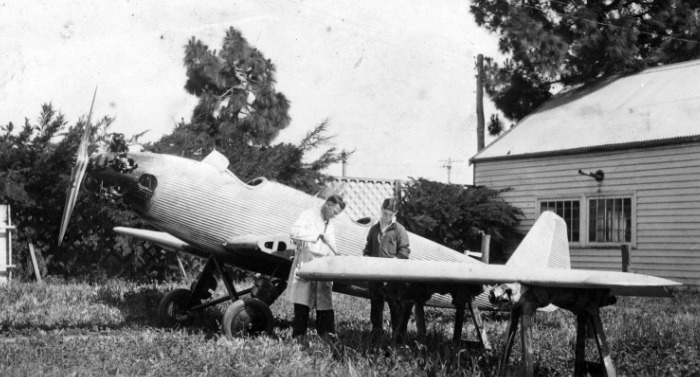
Photo by Geelong pilot ang photographer Charles D. Pratt, courtesy Kevin O'Reilly collection
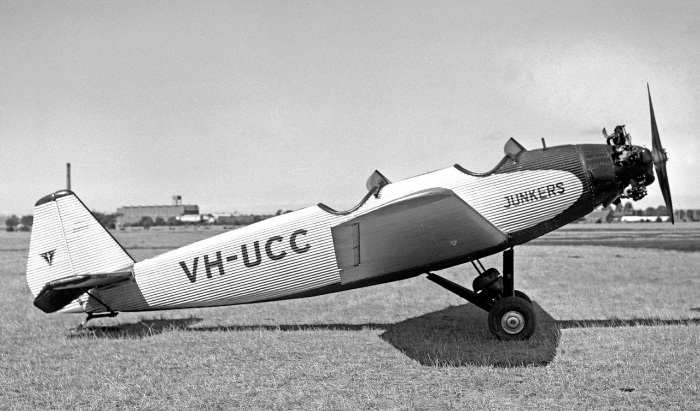


Photos by Brian Baker
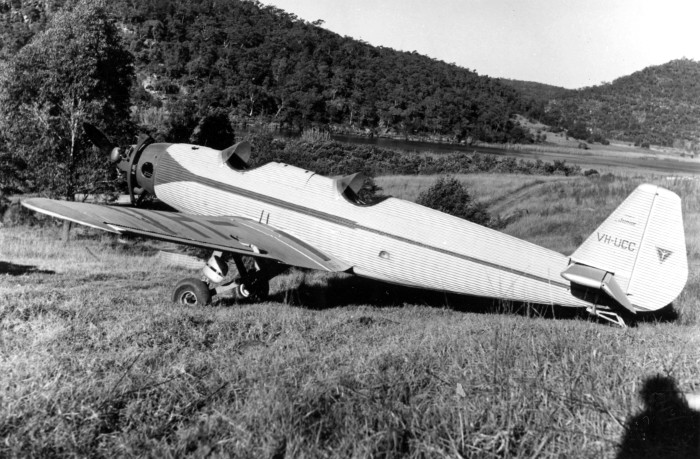

VH-UCC now owned by Mal Rose, stored on a farm at Agnes Banks NSW in October 1974. Photo by Mike Vincent
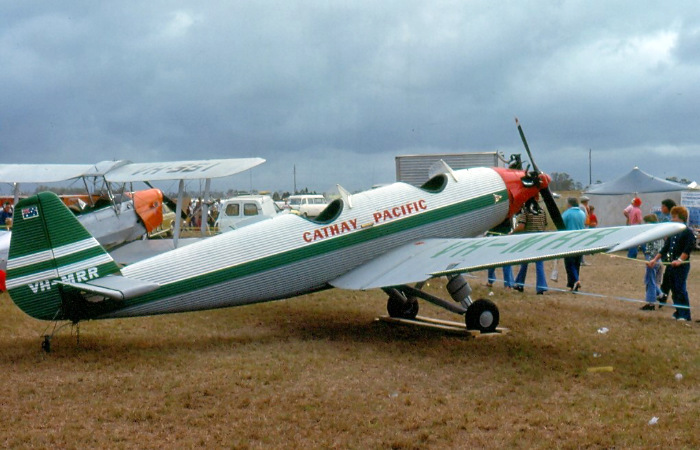
| .30 |
Built at Dessau by Junkers Flugzeug und Motorwerke A.G. Junkers A 50 Junior, c/n 3507 One 80hp Armstrong Siddeley Genet Major radial engine uncowled |
| Swedish CofA was issued in the Luftvardighetsbevis series for aircraft receiving Swedish CofA but no Swedish registration. This was a Junkers arrangement to cover foreign exports while Germany was not a member of ICAN, making German airworthiness certification unacceptable to Australia. Sweden was an ICAN member and Swedish certification was acceptable to the Australian Civil Aviation Branch. |
|
| 28.2.30 |
Arrived at Essendon packed in wooden crates |
| 1.3.30 |
Test
flown Essendon after assembly, pilot H.J.Berryman. He flew the Junior
to Ballarat that same day to display it at an air pageant. |
| 5.3.30 |
Registered VH-UNO H.J.Berryman, Melbourne Vic (Australian agent for Junkers) Named "Wendouree" for Lake Wendourie at Ballarat Victoria, Berryman's home town. |
| With
no prospects of a sale in Victoria, Berryman loaned VH-UNO to Sydney
joy riding and stunt pilot Goya Henry to demonstrate in NSW and
Queensland. |
|
| 5.7.30 |
Goya Henry and Arthur Lamb departed Mascot on a flight to Brisbane to demonstrate the Junior in Queensland. Encountered
very poor weather north of Sydney and turned back from Broken Bay NSW.
Over Sydney beach suburbs in heavy rain the engine began to lose power,
Henry made a forced landing in the suburb of Manley but collided with a
fence and crashed. |
| 5.7.30 |
Crashed Manly, Sydney NSW. Pilot Goya Henry was badly unjured, having a leg amputated. Passenger Arthur Lamb was killed. |
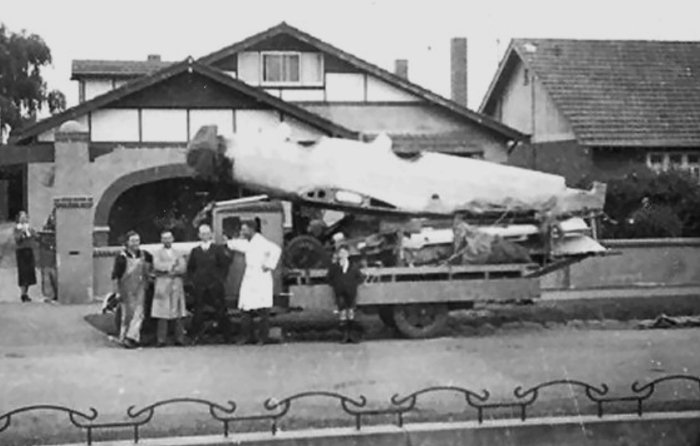
Junkers Junior VH-UNO straight off the ship from Germany was moved to Junkers agent H.J.Berrman's home in the
Melbourne suburb Caulfield for storage while arrangements were made for its assembly at Essendon Aerodrome.
This and the following picture are from H.J.Berryman's collection, courtesy his grandson Hugh Batters.
Melbourne suburb Caulfield for storage while arrangements were made for its assembly at Essendon Aerodrome.
This and the following picture are from H.J.Berryman's collection, courtesy his grandson Hugh Batters.


| 1.37 |
Construction completed at Dessau by Junkers Flugzeug und Motorwerke A.G. Junkers Ju 86B-0, c/n 86/0952. Two Junkers Jumo 205-C-111 diesel engines, cowled Completed in overall light khaki colour with black engine nacelles and black fuselage trim line and registration letters. |
| 1.37 |
Registered D-AGEY Junkers Flugzeug |
| Ordered by Mr.E.F.H. Beinssen, Sydney, a wool broker and German Trade Commissioner. Purchase was a
barter agreement in exchange for a shipment of Australian wool for
German industry. The deal was overseen by Junkers' Australian agent Major H.J.Berryman, Melbourne. |
|
| 2.37 |
German CofA issued. Changes to International policy in 1936 dropped the previous restrictions on German airworthiness certification, allowing Australia to accept the German CofA. |
| 20.2.37 |
Christened "Lawrence Hargrave" in a ceremony at the Junkers works. |
| 20.2.37 |
D-AGEY departed Germany on delivery flight to Australia with a 4 man German crew: Captain Hans Kommol Radio Operator Fritz Reinhardt Engineers Helman Wolfermann and Walter Gerisch. The two engineers were to remain with the aircraft when it commenced operations in Australia. |
| 15.3.37 |
Reached
Darwin from Timor, flying time 69 hours. The port engine failed just before landing causing the aircaft to swing off the runway on to soft ground where it was bogged until pulled free by a tractor. The u/s engine was beyond local repair so a replacement engine was shipped from Germany, arriving at Darwin wharves on 21.4.37 |
| 18.3.37 |
Provisional
CofA and CofR as VH-UYA issued by CAB to cover the remainder of the
delivery flight to Melbourne, where it would undergo Australian
certification inspection. |
| While delayed at Darwin, the German registration and swastika were painted over, replaced by Australian registration VH-UYA. | |
| 26.4.37 |
Departed
Darwin for Melbourne, arriving two days later after flying non-stop
from Charleville. At Essendon the aircraft was imspected by CAB
officers and pilot Kommol gave instruction to pilots from ANA, AofA and
CAB. |
| Beinssen had negotiated a lease
arrangement with Airlines of Australia's Managing Director
G.A.Robinson. The Ju 86 would operate two AofA passenger and mail services each week Sydney-Brisbane-Townsville return. |
|
| 14.5.37 |
Registered VH-UYA E.F.H. Beinssen. Sydney NSW Named "Lawrence Hargrave" |
| 14.5.37 |
Australian CofA issued, 10 passenger seats |
| 14.5.37 |
Delivered
Melbourne-Cootamundra-Sydney by AofA Captain P.T.L. "Lyn" Taylor to
commence the lease by Airlines of Australia Ltd, Sydney. |
| 17.5.37 |
First commercial service with Airlines of Australia, Sydney-Lismore-Brisbane. 6 passengers and 4 crew: Captain Jack Mclaughlin (AofA), J.Kerr (Civil Aviation Board) and the two Junkers engineers who had accompanied the aircraft from Germany. The Ju 86 then continued that day's AofA service Brisbane-Townsville with 10 passengers. |
| 20.5.37 |
Forced
landing at Coffs Harbour airfield NSW due to starboard engine failure
while operating an AofA service Brisbane-Sydney with 5 passengers, no
airframe damage. Crew AofA Captains Keith Virtue and Jack Mclaughlin
and the two Junkers
engineers, who determined that the engine was not repairable.
Passengers and mail sacks were collected by AofA Stinson A and flown to Sydney. A spare Junkers Jumo was sent to Coffs Harbour from storage in Melbourne. |
| Airlines of Australia terminated the lease due to engine unreliabiity. |
|
| Faced with no sales prospects in Australia and no follow-up German orders for Australian wool, Beinssen arranged to return the Ju 86 to Junkers. | |
| 7.37 |
Captain
Keith Virtue ferried VH-UYA to Fishermans Bend, Melbourne for
Commonwealth Aircraft Corporation to dismantle and pack for shipping from the adjacent Port Melbourne |
| 25.8.37 |
Departed Melbourne as cargo on board SS Lippe bound for Germany |
| 26.9.37 |
Struck-off Register |
| .37 |
Registered D-AREY Junkers Flugzeug |
| Became the personal aircraft of Junkers Director Koppenberg as D-ARJF named “Herbert Norkus" |
|
| to Luftwaffe as DD+VL |
|
| Captain Keith Virtue, chief pilot of Airlines of Australia, recalled the Junkers Ju 86 in his biography Virtue in Flying: "We were impressed with it as an aircraft, it was a damned good plane to fly. It cruised at 200 m.p.h. and there was no vibration, but for some strange reason the passengers used to get static electrical shocks from the arm rests. For the initial cold start-up of the aircraft each morning, the two German mechanics with us woud use a charcoal forge to heat up what they called the "hot plug". They would wind the forge up to get the plug good and hot, then they would stick the hot plug into a motor and away it would go with a bang." |

D-AGEY at Darwin on arrival from Germany on 15 March 1937. Fred Niven collection

Now painted as VH-UYA, the Ju 86 refuels at Cloncurry enroute Dawin to Melbourne in April 1937. Photo via John Laming


The Ju86's well-publicised arrival at Sydney to commence operation by Airlines of Australis Ltd on 25 May 1937.
State Library of NSW Hood Collection
State Library of NSW Hood Collection
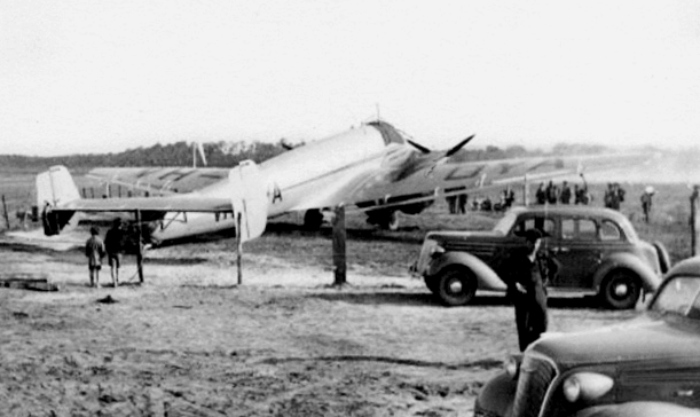
Coffs Harbour NSW 20 May 1937: the forced landing due engine failure which ended Airlines of Australia's interest.
Bruce Robinson collection
Bruce Robinson collection
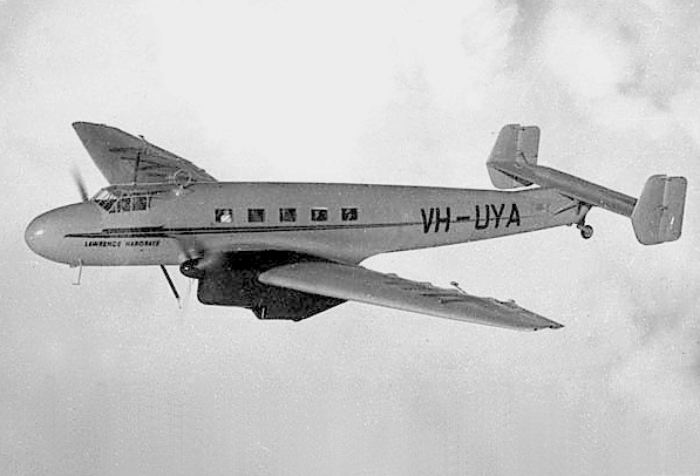
A visiting Junkers W33: Hans Bertram and Adolph Klausman's epic 1932 flight from Germany:
| .29 |
Built under licence by Junkers' Swedish subsidiary company AB Flygindustri at Linhamm, Malmo. Junkers W 33c, c/n 2542 One 310hp Junkers L5 six cyclinder inline engine. |
| Registered SE-ABX |
|
| Registered D-1925 |
|
| Fitted with floats for a flight to Australia, named Atlantis |
|
| 32 |
Departed Germany for Australia flown by pilot Hans Bertram and engineer Adolph Klausmann |
| 14.5.32 |
At midnight the Junkers departed Koepang, Timor for the 7 hour Timor Sea crossing to Australia. Planning to reach
Darwin for breakfast the crew carried no food or water. After flying
through a severe monsoonal thunderstorm over the sea, they were
off-track to the south. |
| 15.5.32 |
Reached
the Western Australian coastline. With fuel running low at dawn they
landed and spent the day ashore but found no sign of civilisaiomn. Next
day they used remaining fuel to fly along the coast, alighted in a
sheltered bay when Bertram powered the floatplane on to a beach. Their location was a remote desolate area of the West Australian far north Kimberley coastline with little white settlement. They were unsure of their location and the Junkers did not have any radio equipment. |
| When Atlantis failed to arrive at Darwin, an aerial search commenced. After 10 days it was called off |
|
| Meanwhile
the desperate aviators had unsuccessfully attempted to walk out but
returned to the aircraft where a nearby water hole kept them alive.
They detached the left float and with the aircraft tool kit managed to
cut the metal to make a canoe with a rudder, mast and sail. When it
proved unmanagable at sea, for the next 5 days they paddled the canoe
attempting to be seen by passing coastal shipping, until they were
exhausted. |
|
| After
40 days, the two men were close to death when found by Aborigines.
Klausmann had become mentally deranged and needed to be restrained. It
took 12 more days to move them to the nearest town Wyndham WA.
Klausmann was unfit to be flown so was sent to Perth by coastal steamer
and then home to Germany. Bertram was flown to Perth by West Australian
Airways for more hospitalisation and recuperation. He made a full
recovery |
|
| 18.9.32 |
Bertram returned to Atlantis on the Kimberley coast by coastal steamer SS Koolinda from Perth,
accompanied by WAA engineer Fred Saxton. They brought drums of fuel,
tools and a float which had previously been used on a WAA DH.50
floatplane in Perth. At the beach, the float was fitted to the Junkers
to replace its left float (which became the canoe) despite it being
smaller and a different design. The Junkers L5 engine was made
operational after standing for 4 months. |
| 21.9.32 |
Bertram test flew the Junkers then flew to Broome WA where he landed on Roebuck Bay |
| 24.9.32 |
Bertram
reached Perth after flying down the WA coastline carrying Fred Sexton.
Landed on the Swan River at Matilda Bay and tied up at the Royal Perth
Yacht Club. Dismantled on land at RPYC then moved by road to Maylands Aerodrome. |
| Reassembled and land undercarriage
installed at
the WAA hangar at Maylands Aerodrome. The DH.50 float was returned to WAA. |
|
| 28.9.32 |
Bertram made a test flight as a landplane, accompanied by engineer Fred Sexton. |
| 29.9.32 |
Bertram
departed Perth in Atlantis to begin a tour of Australia. His story had
been headline news and he was in demand for speaking engagements
and civic receptions across Australia. |
| 29.9.32 |
Crashed during landing at Kalgoorlie WA. His first landing was at Kalgoorlie WA where a crowd of 500 waited at the airfield. Bertram appeared to lose control as the aircraft touched down and swung violently, applied power to become airborne, climbed over the aerodrome fence but struck a tree, ran through another fence and crossed a road before coming to rest on its wheels in a vacant paddock. Damage to wings, undercarriage struts and propeller. |
| WAA engineer Fred Sexton was sent to Kalgoorlie on a WAA Perth-Adelaide service to repair the damage. |
|
| 2.10.32 |
Bertram departed Kalgoorlie to continue his leisurely tour to Adelaide, Melbourne and Sydney |
| 11.32 |
Overhaul
at Essendon Aerodrome, Melbourne by Hart Aircraft Company,during which
extra fuel tanks were installed, reportedly giving an 18 hour ensurance. |
| 9.12.32 |
Bertram
and Australian airline pilot Captain G.U."Scotty" Allen departed RAAF
Station Point Cook, Melbourne for Darwin, where they plan to commence a
record-breaking flight to London in 6 days. Point Cook was used because the Junkers' heavy fuel load required a longer runway than Essendon. |
| 13.12.32 |
Crashed on takeoff Sourabaya, Java. After refuelling 300 gallons, Bertram commenced takeoff at 4am local time. The heavily-loaded aircraft did not perform well in the tropical weather and he closed the throttle to abandon the takeoff, but the aircraft rolled into a drainage ditch. Undercarriage was wrecked but crew unhurt. |
| 11.4.33 |
Bertram departed Sourabaya after repairs had been completed, flying solo home to Germany |
| 17.4.33 |
Arrived at Templehof Aerodrome, Berlin |
| Aircraft was registered D-OVYL | |
| -
The Western Australian Government assessed the total cost of the
aerial, coastal and land search for the downed airmen, which was paid
in full in 1934 by Junkers Flugzeug und Motorwerke A.G. - The detached float was located and dug from sand at the remote beach in 1988 by a team from the WA Martime Museum with the asssistance of the Royal Australian Navy. It was restored and is now displayed in the museum at Fremantle, Perth. - A replica Junkers floatplane was constructed in Sydney for a 1984 Australian ABC TV documentary on Bertram and Klausman's ordeal named FLIGHT INTO HELL. It had a Jaguar car engine installed for floatplane taxying scenes filmed on a dam at Manly Sydney. After filming, the replica was acquired by the Aviation Heritage Museum, Perth. In 2008 it was sold to Australian Aviation Museum at Bankstown Airport, Sydney. Transported by road to Camden Airport NSW, where it was stored in a hangar for several years pending the AAM's planned move to Camden. That did not eventuate and the replica was moved to Bankstown. AAM closed in 2018, replica left outside where fell into poor condition, eventual fate unknown. - Hans Bertram was to return to Australia in August 1941 as a POW during WWII. His Luftwaffe Messerschmitt was shot down by a RAF fighter over the Libya desert during the North African Campaign. He arrived at Brisbane on a prison ship from the Middle East carrying 2,000 German and Italian POWs. |
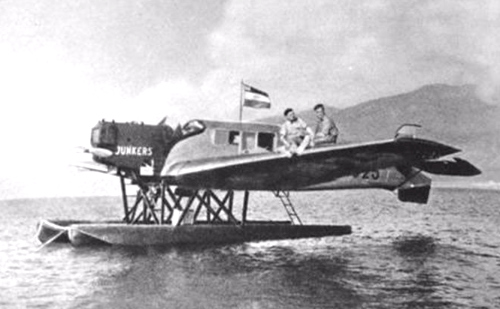
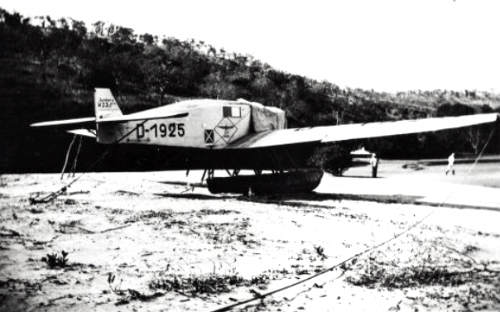
Note the missing left float,which wss used as a canoe. Horrie Miller collection
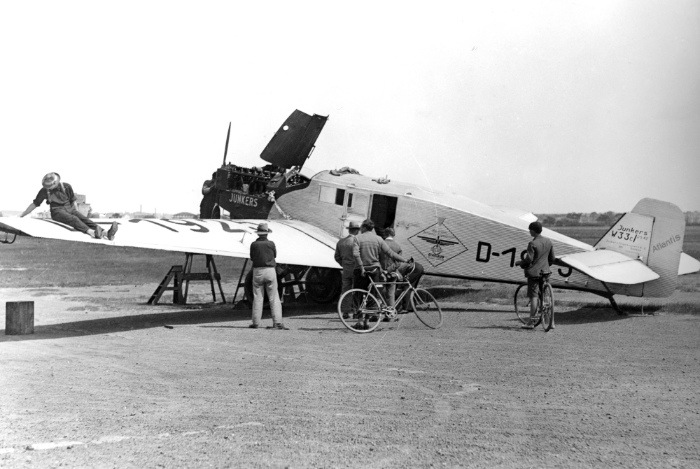
Geoff Goodall collection

This and the following two photographs of the event are courtesy Civil Aviation Historical Society.
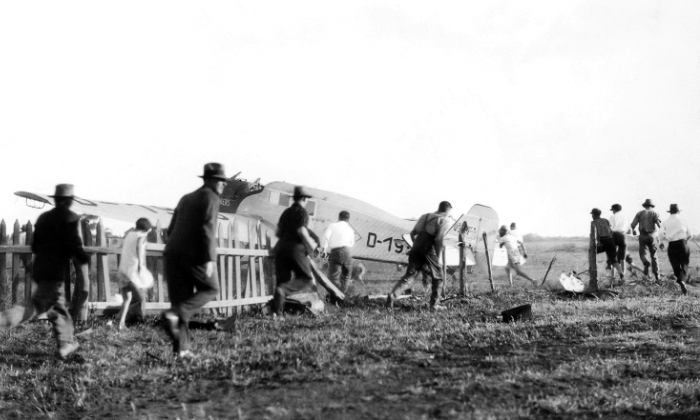
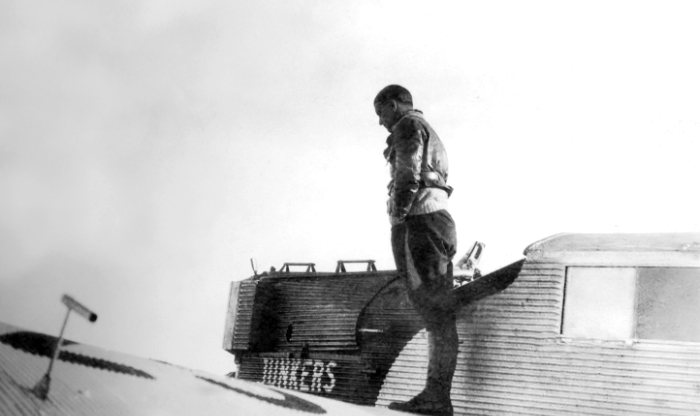

Both photographs by Geelong aviator Charles D. Pratt, courtesy Kevin O'Reilly collection


- Australian Civil Aircraft Register, Department of Civil Aviation and its successors
- DCA aircraft files, National Archives of Australia
- RAAF Aircraft Record Cards, National Archives of Australia
- Trove, on-line newspaper search, National Library of Australia
- War damage compensation valuation New Guinea, DCA file, copy held by Civil Aviation Historical Society Library, Melbourne
- Wings of Gold - How the aeroplane developed New Guinea, James Sinclair, Pacific Publications, Sydney 1978
- Flypast - A Record of Aviation in Australia, Neville Panell & Trevor Boughton, Civil Aviation Authority 1988
- Australia's Two-Airline Policy, Stanley Brogden, Melbourne University Press 1968
- Virtue In Flying - The Keith Virtue Story, Joan Priest, Angus & Robertson Publishers 1975
- 10,000 Hours, Harry Moss, Hesperian Press 1988
- Let There be Flight - a history of flying in western Victoria, Kenneth R. Riches, self-published 2009
- Airlines and Aircraft of the Ansett Airlines Group 1921-2002, Fred Niven, USB version September 2019
- Corrugated Masterpieces - Junkers types in Australia and New Guinea, Jame Richie Grant, Air Enthusiast, Sept-October 1998
- Australian Seaplanes, a listing compiiled by David C.Eyre